Note: If an image ever fails to appear - refresh your page, it really is there
Political Flags of Extremism - Part 2 (n)
(Including Hate Groups, Far-Right, Far-Left, and Ultra-Nationalists)
| Flags of Extremism Part 1 (a-m) | Flags of Extremism Part 2 (n) | Flags of Extremism Part 3 (o-z) |
I agonized over these sections. Whether to ignore these flags and what they stand for, or include them was a tough decision. I feared including them would constitute legitimizing them, and certainly didn't want to do that. In the end I thought it important that they be identified for what they stood for, because many times they have been unknowingly displayed or incorrectly identified as historical by unsuspecting or uninformed individuals or flag companies.
These are flags that many times "migrate" from group to group, many of which rapidy appear and disappear as they change their names, and this makes identification even more difficult. Many of these groups were (and are very small) and don't exist any longer, but their flags continue to be used by other modern extremists. Unfortunately, there are a number of people who, like Ayn Rand's characters in "Atlas Shrugged," think there is something wrong in the world, that the world isn't following the right value system. As an alternative, they get into extremist politics like anarchism, environmentalism, neo-fascism, and radical traditionalism. The scary part is that this page only identifies a small portion of the Flags of Extremism being sold today. The sad truth be known, any flag or cultural symbol's true meaning can be used, then distorted and eventually destroyed by their misuse by these extremists groups.
Please be aware that in NO WAY does this site support the beliefs, policies, or philosophies of these organizations, nor encourage the displaying of these flags.
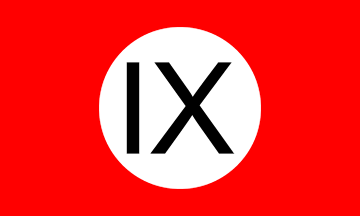
N9S Flag
|
The November 9th Society (United Kingdom)
The November 9th Society, later renamed the British First Party, was a British neo-Nazi movement started by Terry Flynn in 1977. It claimed to have chosen its name in memory of the second day of Hitler's 1923 Beer Hall Putsch in Munich, when 16 National Socialist were killed. Opponents of the N9S claimed that the real date behind the name was the Crystal Night in 1938. This is often thought to be the actual beginning of the Holocaust. In 2007, the N9S changed its name to the British First Party, and began using traditional flags and symbols such as the Saint Anthony Cross and the Union Jack, which is typical of the British far right, attempting to avoid direct association with National Socialism.
The original flag of November 9th Society was derived from the Nazi flag by replacing the swastika with Roman numeral IX. |
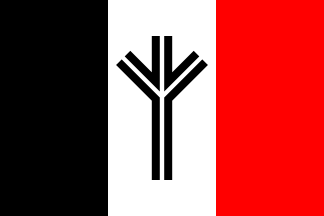
Original NA Flag
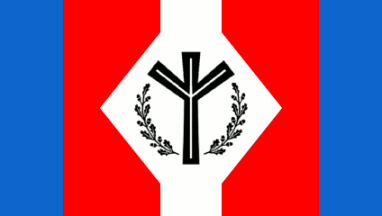
Variant NA Flag
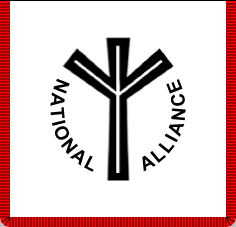
NA Vertical Banner
(reported in California)
|
National Alliance (USA)
The white separatist political organization National Alliance (NA) was once labeled as the United State's fastest-growing neo-Nazi group before the death of William Luther Pierce in 2002. The NA had been founded by Pierce in 1974, and was first headquartered in Hillsboro, West Virginia. At the time of his death in 2002 it ran a white power record label called Resistance Records and ran "Resistance Radio", a (now defunct) web radio station that streamed white power rock music across the Internet 24 hours a day and claimed 250,000 regular listeners in America (unverified). It also had a radio show, American Dissident Voices, heard on shortwave and streaming audio on the Internet. This group hoped to secure a white living space within North America, where "the physical and cultural presence of all non-whites has been removed." Constant power struggles after Pierce's death led to a steady decline of NA membership and in 2013, its end was
officially announced.
The original flag of the NA dating back to the 1970s was a black-white-red tricolor mirroring the Imperial German flag and the NSDAP colors. It also looks much like the flag used by the Volksfront, a group formed in Oregon in 1990s. (If there is a relationship between the two groups, other than their flag designs, it is unknown.) The last known NA flag had five vertical stripes of blue-red-white-red-blue, with a "life" rune surrounded by an oak wreath on a white diamond in the center.
A point of interest is that the life-rune had been used during Nazi as part of the logo of German pharmacies and which after World War II was replaced by the snake and bowl symbol.
A white banner was also used by the NA with the group name inscribed instead of an oak wreath surrounding the "life rune", all black on white field. The flag was square, hoisted vertically, and had red fringes which added a pseudo-Nazi look to the whole design. This banner was seen in a photo alleging to have been taken in Sacramento, California, in 2002 or earlier. |
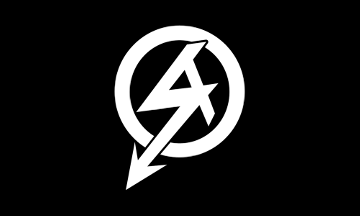
NA Flag
|
National Action (United Kingdom)
National Action was founded in 2013 and banned as a terrorist organization in December 2016, after a number of arrests of its members for violent crimes and preparing terrorist actions, as well as frequent calls for their performing. The first far-right group in the UK made illegal since the WW2, it is believed to have continued operating more secretly, using other groups as its legal cover; some of those, including Scottish Dawn, have later been banned on that ground.
Flag of National Action was black, charged with a white emblem consisting of a combination of lightning bolt and letter A, terminating in an arrow and placed over a ring. That was clearly derived from the emblem of Assault Division of the German Nazi Party, but also bears some resemblance with that of the British Union of Fascists. |
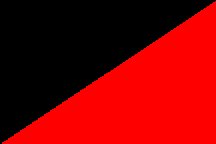
Nation Flag
|
Nation (Belgium)
Nation
Nation is a French-speaking ultra-rightist movement, founded in 1999 in Wallonia and Brussels. They claim to be "the only French-speaking nationalist organization struggling in a credible way against the multiculturalist society." In 2000, they formed a youth branch called Jeune Nation (Young Nation).
Nation has participated in demonstrations in Belgium and in other European countries in recent years, together with other like-minded European "nationalist" groups. Their flag has been identified as the flag of "national-anarchism" and it's use has spread. However, their actual political success has been limited. |

NBF Flag - Type #1
(without hammer)
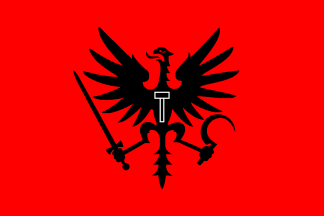
NBF Flag - Type #2
(with Hammer)
|
National Bolshevik Front (Russia)
National Bolshevik Front has been used as a name by three separate far-right groups in Russia. The name initially applied to the Russian National Bolshevik Party of Eduard Limonov when it was founded in 1992. Although the name was soon abandoned by the Russian group when it became active in politics, the term National Bolshevik Front is still used to refer to a loose federation of National Bolshevik organizations that spreads across much of Europe and South America. Of these, the most important is still in Russia.
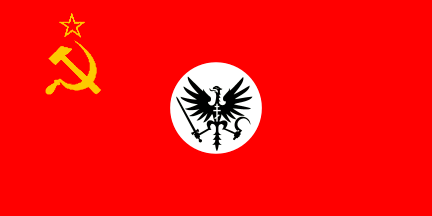
NBF Variant 2012
(Seen in Odessa, Ukraine)
In 2006, the name was once again taken, this time by Alexei Golubovich for a new anti-Limonovist splinter group from the National Bolshevik Party that he led. This new group has links with former NBP member Aleksandr Dugin, and works closely with the Union of Eurasian Youth, a group of young supporters of Dugin's Neo-Eurasianism. On their flag, reportedly borrowed from some German Weimar-era extremists, hammer (frequently omitted), sickle and sword stand for
the workers, peasants and soldiers, respectively, as also used in early Soviet Russia. |
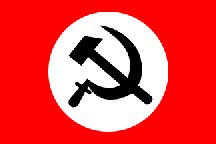
NBP Flag Type #1
(shown here in 2:3 size ratio)
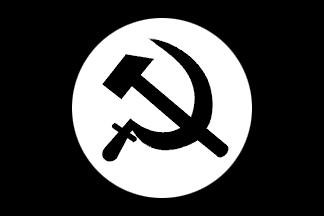
NBP Flag Type #2
(shown here in 2:3 size ratio)
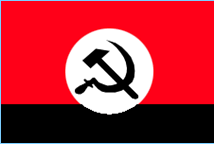
NBP Flag Type #3
City and region of Pskov
(shown here in 2:3 size ratio)
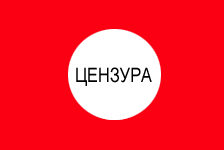
NBP Flag Type #4
The "Censored" Variant
(shown here in 2:3 size ratio)
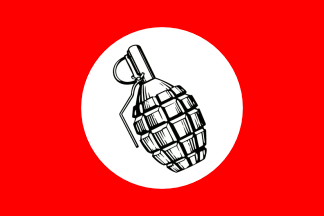
NBP Flag Type #5
The "Hand Grenade" Variant
(shown here in 2:3 size ratio)
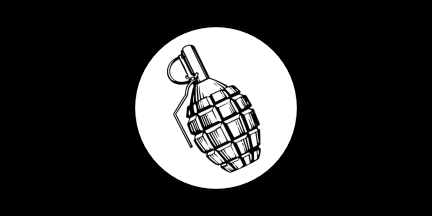
NBP Flag Type #5d
The "Hand Grenade" Variant
(shown here in 1:2 size ratio)
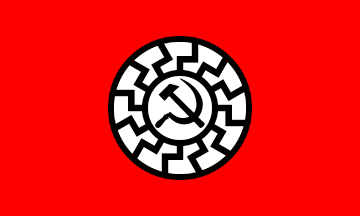
NBP Flag Type #6
The "BlackSun" Variant
City and region of Volgograd
(shown here in 2:3 size ratio)
|
National Bolshevik Party (Russia)
"Natsional-Bol'shevistskaya Partiya
The Natsional-Bol'shevistskaya Partiya (NBP) has been led by Eduard Limonov since it was first founded in 1992 as "National Bolshevik Front." It was formed by the combining six smaller far-right Bolshevik groups. This newly formed National Bolshevik Party, also known as Nazbol, was dedicated to the ideology of National Bolshevism. Their platform called for a revolution and transforming Russia, enlarged with the parts of neighboring ex-USSR states which have significant Russian population, into a unitary state with the political and economic system similar to that of the former USSR, but with the highest state offices being reserved for ethnic Russians. Such a transformed state would spread its domination over most of the Eurasia, not unlike the Soviet domination in the Warsaw Pact and the Comecon. Since 2005, the party was barred from election registration and was completely outlawed in 2007.
|
|
|
NBP Flag Type #1b
(shown here in 1:2 size ratio) |
|
NBP Flag Type #1c
(shown here in 1:1 size ratio) |
In 2010, Eduard Limonov founded another neo-Bolshevik party, named "Other Russia," which replaced all of the National Bolshevik flags with a black-yellow-white horizontal tricolor, charged with the party name inscribed in black on the yellow field. It seems that not all the members of National Bolshevik Party have followed their leader into his new party and that some of them have formed a number of new organizations, which might have kept some or all of the old flags in use.
|
|
|
NBP Flag Type #2b
(shown here in 1:2 size ratio) |
|
NBP Flag Type #3b
(shown here in 1:2 size ratio) |
Their flag is based on the nazi scheme (red or black, with a centered white disk with a black symbol, but instead of the swastika there they use the sickle-and-hammer device. The flag is an interesting merging of two well-known and opposite symbols, which reflects the strange merging of the Bolshevik and Nazi doctrines. The flag (type #4) appeared after the red flag with black hammer and sickle was banned, the word "CENZURA" basically means "censored," and was later replaced with the black flags with hammer and sickle (Type #2).
|
|
|
NBP Flag Type #4b
(shown here in 1:2 size ratio) |
|
NBP Flag Type #4c
(shown here in 1:1 size ratio) |
Although red flag with black hammer and sickle on a white disc was
banned in 2007, there still is a flag whose design contains all of these elements and combines them with the "Black Sun," an occult symbol which is occasionally used by the neo-Nazis, thus producing another flag in the series of vexillological oxymora which are so characheristic for the neo-Bolsheviks. This flag (Type #6) has a large white disc, edged with the outer ring of the "BlackSun," and a smaller disc, edged with the inner ring of the "BlackSun" and charged with black hammer and sickle, all on red field.
|
|
|
NBP Flag Type #5b
(shown here in 1:2 size ratio) |
|
NBP Flag Type #5c
(shown here in 1:1 size ratio) |
Another way of getting around the symbol banning ordinances has been a series of flags produced with hand grenades replacing the hammer and sickle symbol in the central white disk, although it hardly indicates a peaceful law abiding organization. Apparently, the war-like symbol has great appeal to the mentality of people who become members of these extremist groups and its not surprisingly these flags have appeared in a variety of sizes, ratios (with both black and red backgrounds), and seem to be becoming increasingly popular at NBP public rallies. Such flags were used in Russia as early as in 2002, and are very popular in various mirror party branches like those in Latvia and Lithuania. These flags, as well as some of the variants with the hammer and sickle, have also seen use by Eduard Limonov's new "Other Russia" party.
|
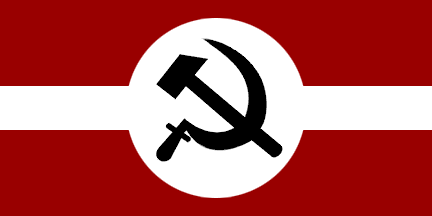
NBP-Latgalia Flag
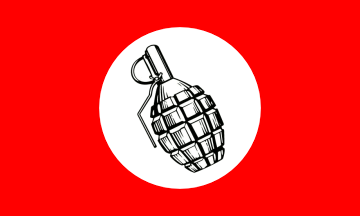
NBP-L Flag Type #1
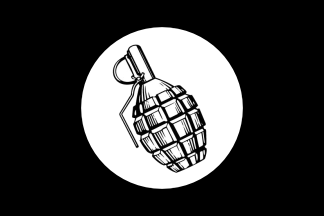
NBP-L Flag Type #2
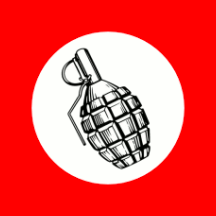
NBP-L Flag Type #3
|
National Bolshevik Party of Latvia (Latvia)
Latvijas nacionalbolševiku partija (Latvian)
Natsional-Bol'shevistskaya Partiya Latvii (Russian)
The National Bolsheviks in Latvia (NazBols) are a very active, but small movement centered mostly around Latgalia. Latgalia is a province in the south-eastern part of Latvia. Historically, Latgalia has a political and cultural history very different from that of the rest of the Latvia, which were long under German-Swedish rule. Latgalia remained under Polish-Lithuanian rule until 1772, when it was ceded to the Russian Empire. Today, this part of Latvia is almost entirely inhabited by ethnic Russians.
The leader of the Latvian National Bolsheviks is Vladimir Linderman (known by the nickname "Abel"), who states that he "protects the interests of the Russian-speaking population of Latvia, whose rights are violated in the former Soviet Republic every day." In 2002, Linderman fled to Russia for political asylum because the Latvian authorities blamed Linderman for an attempt on the life of President Vaira Vike-Freiberga. Since 2002, Linderman has been a member of the Central Committee of the National Bolshevik Party. In 2007, Linderman was one of the organizers of the Dissenters March and afterwards was deported from Russia to Latvia in 2008. He was accused of storing explosives and of calling for the overthrow of the political system. Later he was found innocent by Latvian courts of the charges, and in 2009, Linderman became the founder and leader of the "13th of January Movement."
It is interesting to note, that Ayo Benes, one of leaders of the National Bolshevik Party of Latvia, is the son of an Ugandan immigrant and his Russian wife. This detail seems to reveal that the Latvian NazBols are generally not such racists as members of most of other groups from Russia and the ex-USSR.
|
|
|
NBP-L Flag Type #4 |
|
NBP-L Flag Type #5 |
In NBP of Latvia is active in most anti-capitalist demonstrations in Latvia and was involved with blockades against Soviet Socialist Veterans' Day Parades during Latvian Legion Day. In organization they follow the Russian National Bolshevik Party model. In all activities they either fly the Russian National Bolshevik Party flags (either red or black fields with a centered white ring with a black hammer and sickle inside), or the striped NBP-Latgalia variant.
Some of the NazBols most favored demonstration flags have centered hand grenades on fields of red or black, although usually rectangular in shape, they have also used square shaped variants of the flags. Such square flags were seen in Riga in 2005 during protests against the visit of President George W. Bush to Latvia. |
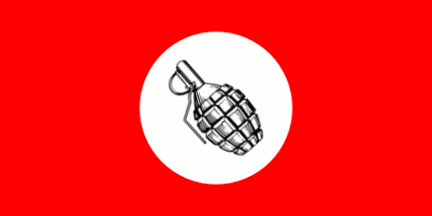
NBPL Flag
|
National Bolshevik Party of Lithuania (Lithuania)
Lietuvos nacionaline bolševiku partija (Lithuanian)
Natsional-Bol'shevistskaya Partiya Litvy (Russian)
The National Bolshevik Party of Lithuania uses the red flag charged with a hand grenade drawn in black and placed in center of a white disc. Such flags were seen in the city of Klaipeda during several protests against the closing down of Russian-language schools in 2006. Over 28% of the citizens of Klaipeda are Russians, which gives it the greatest Russian population in Lithuania, and it has the only Russian-language secondary school in the country. During these protests party activists also wore arm bands that repeated the flag pattern.
The usual neo-Bolshevik flags and arm bands with the hammer and sickle are probably not in use at all in Lithuania because the symbol is legally banned. Due to the lack of any recent news, it is also questionable whether the party is still active. Not only is the Russian population in Lithuania much smaller than in other Baltic countries, but National Bolshevism seem to have never been very popular there, and apparently the Russian population in Lithuania usually prefers less extreme political options. |
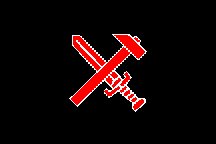
National Resistance Flag
|
National Resistance (Germany)
Nationaler Widerstand
This flag is a symbol for the Nationaler Widerstand. It's not used by a particular party or organization, just for the whole action called "National Resistance." Recently, it has been used by organized Neo-Nazi groups in Germany, and it symbolizes national resistance.
This flag actually predates the National Socialist Movement. The black flag (without hammer and sword) was the flag of a social protest movement of German farmers in the 1920s. The black flag with the red hammer and the red sword was first used by Otto Strasser, who was one of the leaders of the left wing of the NSDAP in the 1920s. It symbolized the unification of workers and soldiers. After World War II, Strasser reintroduced the black flag with the red hammer and sword as the flag of a short-lived new political movement that never gained any importance, however, in the 1970s and 1980s the flag was reintroduced by newer neo-Nazi movements. In the 1990s, it became a symbol of national revolution, and has remained in use since that time. |

NBP-B Flag Type #1
(proposed)
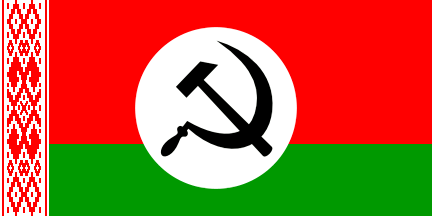
NBP-B Flag Type #2
(proposed)
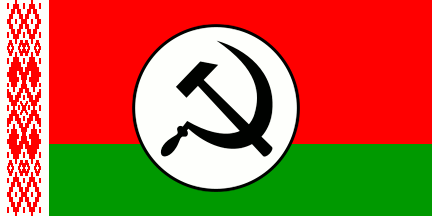
NNBP-B Flag Type #3
(proposed)
|
National Bolshevik Party of Belarus (Belarus)
In Belarus, activities of the National Bolshevik Party are fairly minor, mainly vandalism, such as NBP emblems drawn on church walls and foreign embassies. Since they support stronger ties between Russia and Belarus, but also oppose current governments in both countries, they have become opponents to both the government and to most of Byelorussian opposition who mostly favor distancing themselves from Russia. The National Bolshevik Party is not even officially registered in the country.
However, when Eduard Limonov founded another Russian party in 2010, named "Other Russia," the National Bolshevik Party in Belarus split into two groups. A faction seems to have transformed itself into the "Autonomous National Bolsheviks of Russia and Byelorussia" choosing not to follow Limonov's lead. Curiously, they seem to have switched to a black-yellow-white flag, which is also the basic design used by "Other Russia."
Another group continues to call themselves the "National Bolshevik Party of Belarus" maintaining a separate website for themselves. Unfortunately, their new website generally shows no flags, although the hammer and sickle within a disc are used as the emblem on their graffiti, on their demonstration posters, and on the party T-shirts (usually red), as well as on the website pages header, where a red map of Belarus is charged with a black hammer and sickle within a white disc. This party seems to be maintaining good relations with the "Other Russia," which has held rallies in support of a Belarusian NazBol who was arrested in Moscow during demonstrations
The National Bolshevik Party of Belarus normally used both the red and black fielded versions of the Russian National Bolshevik Party Flag, like all similar satellite party branches, but at one time had plans to use distinct Belarus Branch Flags which are shown here. The break-up of the party seem to have ended these plans. |

NC Flag - Type #1
(reported - undocumented)

NC Flag - Type #2
(reported - undocumented)
|
Nationalist Coalition (USA)
In 2006, the National Vanguard, itself a descendant of the National Alliance, underwent a split and a new white supremacist group, the Nationalist Coalition, was formed under the apparent leadership of Robert Jay Mathews and Todd Weingart. It is particularly active in Tampa and St. Petersburg (Florida), but has claimed membership as far west as Phoenix, Arizona. Professing to be "a new kind of white activism," its membership spread the usual racist and anti-Semitic propaganda in a variety of Florida towns and cities, have rented billboards promoting the group’s web site, and have distributed racist music CDs.
They are convinced that "Jews control the media in America...and in nearly every European country of significant influence, including Great Britain and Russia." They claim the Supreme Court, which they label the "Jewish Supremacy Court," is also controlled by the Jews. Their goals seem to be building a national pro-White party whose platform would be to establish a White living space. This space will be completely free of all non-Whites. They also sponsor a radio program called Nationalist Matters "...to educate and enlighten our people - people of European descent." They have created an annual scholarship competition "...to reward that driven student who has demonstrated commitment to helping the White community."
The two flags reported here are very speculative in nature and their actual use is yet to be verified or documented. The basic design places the movement´s "odal rune" emblem on a blue or red field, the colors favored by their parent organizations. |
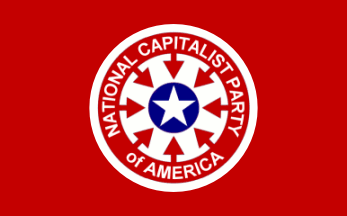
NCP Flag - Type #1
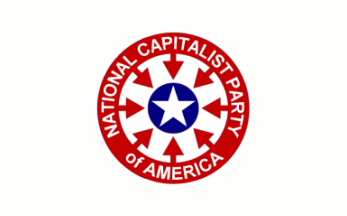
NCP Flag - Type #2

NCP Flag - Type #3
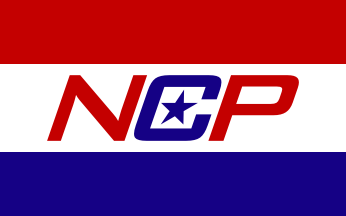
NCP Flag - Type #4
|
National Capitalist Party (USA)
National Capitalist Party (NCP) was founded in 2008 by members of the Christian Falangist Party of America (CFPA), led by Patricio Cortes Bridges (a.k.a. Pat Bridges), founder and longtime National Director of the CFPA. The new party was meant to be the secular replacement of the old one, while most of the party goals remained the same. The NCP clearly did not have much success, because Bridges and part of his followers went to refound the CFPA as the Christian Phalange Organization in 2010, leaving the NCP to exist only via its website until late 2011, although the two organizations might have been originally intended to co-operate, for some of the NCP logos have been appearing at the Christian Phalange website since it was created. The NCP had previously tried to found a same-named Cuban party in exile, which seems to have died out even before its model.
The main party flag has had three versions, with the field either in red, or white, or blue, and was charged with the main party logo in center. The logo was a white disc with red border, charged with what appears to be very similar to a 1942 military aircraft roundel in the center (a blue disc charged with a white star), and with eight white arrows emerging from the ring and pointing towards the central roundel; the ring was charged with the inscription "NATIONAL CAPITALIST PARTY of AMERICA", which might have been the official party name, although the territorial designation seems to have been rarely used, even in the logos. The roundel in center was meant to represent America herself, red border symbolized the blood shed in its defence, the arrows symbolized the cardinal and ordinal directions and therefore the unity of the country, while the complete red shape - ring with the arrows - was also meant to represent a wheel, symbolizing the progress and the Capitalism. On the flags with red or blue fields, the logo was surrounded with an additional white border.
An Alternate party flag was a red-white-blue horizontal triband, with white field wider than the other two and charged with one of alternate party logos, which consisted of large oblique letters "NCP", letters "N" and "P" in red and letter "C" in blue; the letter "C" was enclosing an oblique blue five-pointed star. The typeface was almost identical to Bank Gothic in bold oblique form.
Other logos, including a red-blue rhinoceros charged with three stars or letters "NCP" in white, clearly designed to resemble the Democratic donkey and Republican elephant, seem not to have been used on the flags. All these flags and logos might have been designed by party leader Pat Bridges, as seems to have been the case with those of his earlier and later political organizations. |

ND Flag
|
National Democrats (Sweden)
Nationaldemokraterna (ND)
The National Democrats are a minor far-right nationalist party in Sweden, headquartered in Stockholm, and formed by a faction from the Sweden Democrats in 2001. The current party leader is Marc Abramsson. The party describes itself as a democratic nationalist and ethnopluralist party (ethnopluralism supports policies of forced regional ethnic and racial separatism). In General Elections the party has failed to receive anything near the 4% necessary for parliamentary representation, however, they do currently have representation in several city governments south of Stockholm. The ND supports a small newspaper called the Nationell Idag and is affiliated with both the Euronat and Alliance of European National Movements.
In 2008, the party replaced its old logo (consisting of a blue and yellow sail) with a white cloudberry flower on orange field. At demonstrations the ND uses a plain orange flag. |
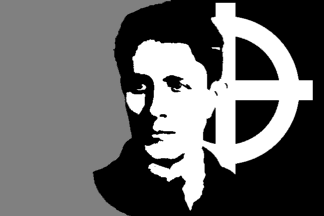
ND Flag Type #1
Corneliu Zelea Codreanu
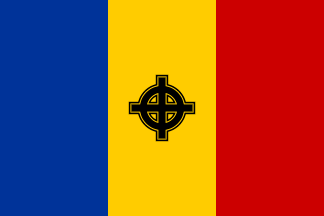
ND Flag Type #2

ND Flag Type #3
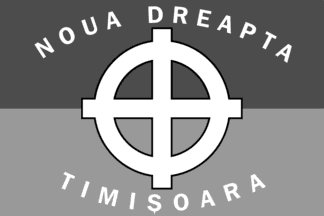
ND Flag Type #4
Timisoara branch
|
New Right Party (Romania and Moldova)
Noua Dreapta (ND)
The New Right is a neo-fascist organization founded in 2000. It sees itself as successor to the Romanian fascist organization "Iron Guard" (Garda de Fier) led by Corneliu Zelea Codreanuo in the 1930s. The Noua Dreapta is an active member of the far-right European National Front, the coalition of neo-nazi political parties in Europe. The New Right's targets include sexual minorities, Catholics, abortion, communism, capitalism, globalization, the European Union, NATO, race-mixing, and all religious groups other than the Eastern Orthodox Church. As the Noua Dreapta reveres the historical leader of the Iron Guard, Corneliu Zelea Codreanu, they show a portrait of him together with the Celtic Cross on another flag Type #1.
|
|
|
|
|
ND Flag Type #5 |
|
ND Flag Type #6 |
|
ND Flag Type #7 |
ND Flag Type #2 with a black Celtic cross in centre of yellow field of the Romanian National Flag was used at a demonstration in Timisoara in 2011. The demonstration was held before the Consulate of Serbia as a protest against the "persecution" of ultra-rightists in that country. Apparently, a "football hooligan" was charged with the attempted murder of a policeman during riots which broke out at a national championship match and a group of those were charged with the murder of a French football fan before an international match in Belgrade. These are examples of ultra-rightists' attempts - unfortunately, often successful - of infiltration among the football (Soccer) fans with the ultimate goal of converting them to their ideology, typical not only in Romania and Serbia, but in other European countries as well.
New Right Flag Type #3 uses the current logo of the ND, which is a white rhomboid charged with party initials in black and placed in centre of a larger green rhomboid, which also contains the party name inscribed in white above and below the central device. This logo is based on a common template used by other ultra-rightist movements which are the members of European National Front. This flag was used in Spain in 2011, at the celebration of 74th Anniversary of the Battle of Majadahonda, which was organized jointly by several Romanian and Spanish ultra-rightist parties, and also in Rome in 2011, during the celebration of anniversary of Nationalist victory in Spanish Civil War, which was organized by the National Association of Italian Fighters in Spain, with the participation of Spanish and Romanian ultra-rightists. The New Right was involved in these events as the self-designated successor of the Iron Guard, whose members fought in the Spanish Civil War on the Nationalist side, some of them having been killed at Majadahonda.
The New Right Flag Type #4 is used by the New Right Timisoara Branch and ND Flag Types #5, #6, and #7, although generic extremist Celtic Cross flags, have also seen use by the Noua Dreapta at various demonstrations and rallies. |
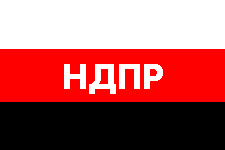
NDPR Flags
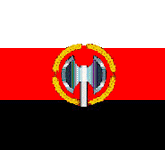
|
National Sovereignty Party of Russia (Russia)
The National Sovereignty Party of Russia (NDPR), or National-State Party of Russia is a extremist Russian nationalist party established in 2002 under the leadership of Alexander Sevastyanov and Stanislav Terekhov. It is affiliated with the Russian National Movement, and the Movement Against Illegal Immigration (DPNI), Russian National Union (RONS) and other extremist nationalist organizations. The party leadership openly states "Our goal is power. We don't hide the fact that a party of nationalists will come to power. We should throw both democracy and Jews out of Russia." The NSPR is, perhaps, not neoNazi, but ultra-rightist extremist, for sure.
Anti-Semitic and pro-Nazi sentiments are predominantly among the officers of the Russian army, Interior Ministry (police) and FSB. Among the 11,000 National-State Party members, 7,000 are acting or former officers.
In 2002, the World Congress of Russian Jewry, published in the newspaper "The Jewish Word," accused the party of "inciting hatred of the peoples living in Russia, primarily the Jews." In response, representatives of the party filed a lawsuit for libel and demanded to recover from Berel Lazar 1.3 million rubles. In 2004, the court ordered Berel Lazar to apologize and pay damages of 100 rubles."
In 2003, the Ministry of Justice of the Russian Federation issued a formal warning to the party of the inadmissibility of the implementation of extremist activities. In May of 2003, the NDPR was excluded from the unified state register of political parties. |
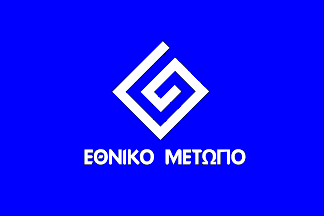
|
National Front (Greece)
Εθνικο Μετωπο
The National Front is an extreme far-right Greek nationalist political party established in 2012 by former members of such groups as the National Political Union (EPEN), Greek Front, Golden Dawn, and other parties of the same political orientation. It is led by Manos Konstas and headquartered in Athens. The groups ideology is a combination of extreme nationalism, patriotism, conservatism, anti-semitism and anti-communism.
The flag of National Front is blue with the party's emblem and name ΕΘΝΙΚΟ ΜΕΤΩΠΟ (National Front) in
white. |
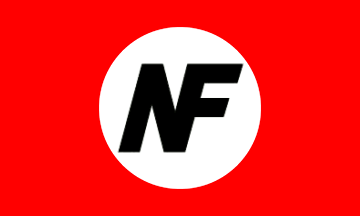
NF Flag (Type #1)
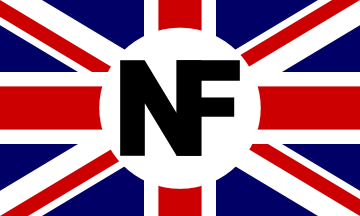
NF Flag (Type #2)
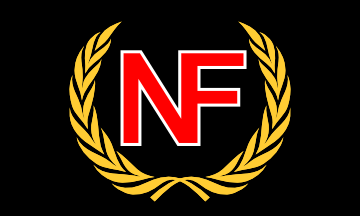
NF Flag (Type #3)
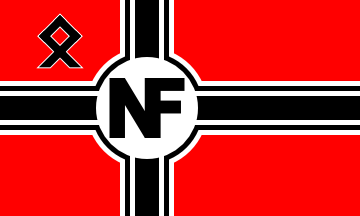
NF Flag (Type #4)
|
National Front (United Kingdom)
The National Front was founded in 1967 by a fusion of several far-right groups, including parts of the original British National Socialist Movement. The NF become one of the strongest far-fight organization by the mid-1970s, but never had any success in elections. Most of its activities were marches and demonstrations, which frequently ended in violent clashes with anti-Fascist and far-left groups. This lack of success led to internal conflicts resulting in several splits; the most notable in 1982 resulting in the formation of the current British National Party.
While being consistently racist, the National Front has always denied the accusations of Nazism, describing its openness towards the Nazi ideas as its support for free speech. Police and prison services in the UK forbid their employees to be members of the party.
|
These large indoor banners where similarly designed, sometimes in square or nearly square shapes. They were charged with the National Front logo and additional inscriptions. They all had either red or black backgrounds.
The banners have been used as backdrops by far-right rock bands in their musical videos and performances.
The monogram on the black variant appears to be thinner than that on the red banner. This made it very similar to those displayed on demonstration posters of the early 1980s. |
|
The party emblem is the monogram NF, as one of the flags (type #1) is clearly derived from that of the Third Reich by replacing the swastika with black oblique monogram. Another flag (type #2) is similar to that of the Imperial Fascist League. A third flag (Type #3) is black, charged with a red monogram, fimbriated white and surrounded with two golden olive branches similar to the white ones used by the United Nations. Type #4 is derived from the 1938-1945 war ensign of the Third Reich by replacing the swastika with black monogram NF, removing the inner black border from the disc, and replacing the Iron Cross in the canton with the black odal rune fimbriated white.
|
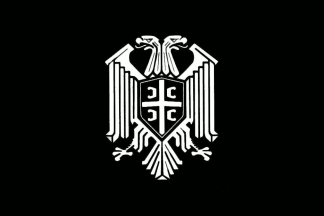
NF Flag, Type #1
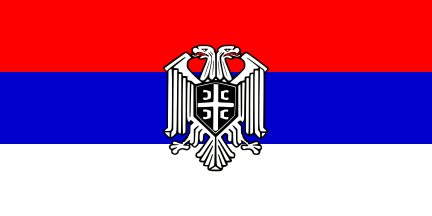
NF Flag, Type #2 |
National Formation (Serbia)
Nacionalni stroj
The National Formation was a Serbian neo-Nazi skinhead organization which gained nationwide attention in 2005 by physically assaulting participants of an anti-Fascist gathering at the Faculty of Philosophy in City of Novi Sad. Previously they had been responsible for racist and anti-Semitic graffiti, as well as those glorifying persons indicted before The Hague Tribunal, which have been appearing in Belgrade, Novi Sad and other towns. Their activities included clashes with both participants and police at other anti-Nazi counter-rallies and blatant spreading of racist slogans at Serbian soccer matches, especially those aimed at players of African origin. All this resulted in fifteen NF members being arrested and sentenced to prison in 2008. In 2011, the Constitutional Court of Serbia banned the NF completely, the first such case in Serbia. The leader of the NF was Goran Davidovic, nicknamed Führer, a history student from Novi Sad.
In late 2008, many active members migrated to a new organization called the New Serbian Program (NSP) because of the police crackdowns.
The main flag of National Formation was black, charged with a simplified version of Serbian coat of arms in white. This emblem was copied from a banknote issued in 1942 by the puppet government which was installed in Serbia by German occupational forces. The same emblem, with a black border, was added to the national flag of Serbia to make their other flag. Both flags, especially the latter one, have remained popular among Serbian ultra-rightists even after the National Formation ceased to exist.
|
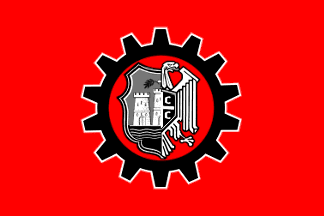
Novi Sad Nationalists Flag
|
Novi Sad Nationalists (Serbia)
Nacionalisti Novi Sad
Novi Sad Nationalists seem to have been active in 2015 and 2016, as all the news reports about them date from these two years. Most likely, the group was a local successor of the National Formation, formed by its previous members. After this time, the members probably dispersed, having joined other similar groups.
The flag of Novi Sad Nationalists was red, charged with black cogwheel (a symbol sometimes used by neo-Nazis) with a white outer fimbriation, enclosing a complex emblem: a half of the shield of arms of the City of Novi Sad, depicted in black, gray and white, combined with a half of the emblem of National Formation - an arrangement called "dimidiation" in heraldry. |

NSF Flag
|
National Serbian Front (Serbia)
Nacionalni srpski front
National Serbian Front (NSF) was founded in early 2016 as another attempt to found a legal ultra-rightist organization in Serbia. Whether it has been registered or not (which they did intend to do), it seems to be still operating legally, although there were requests for their banning. Beside Serbia, they claim to be active in parts of Bosnia and Herzegovina as well. While they do not claim to be exactly Nazis, their symbols reveal them as such, as does the fact that many known neo-Nazis are their members.
The flag of NSF is black, charged with a large emblem in the center: white Cyrillic initials "NSF" on a blue rhomboid, which is centered in a larger red rhomboid with inner white and outer red fimbriations. The emblem resembles that of the New Serbian Program, as well as those of New Force (Italy) and New Right (Romania). These similarities, officially stated as intended, also suggest that the design may have been created by Goran Davidovic, previous leader of National Formation and New Serbian Program, currently known to actively support the NSF from the exile in Italy. |
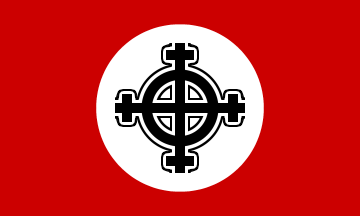
NFP Flag
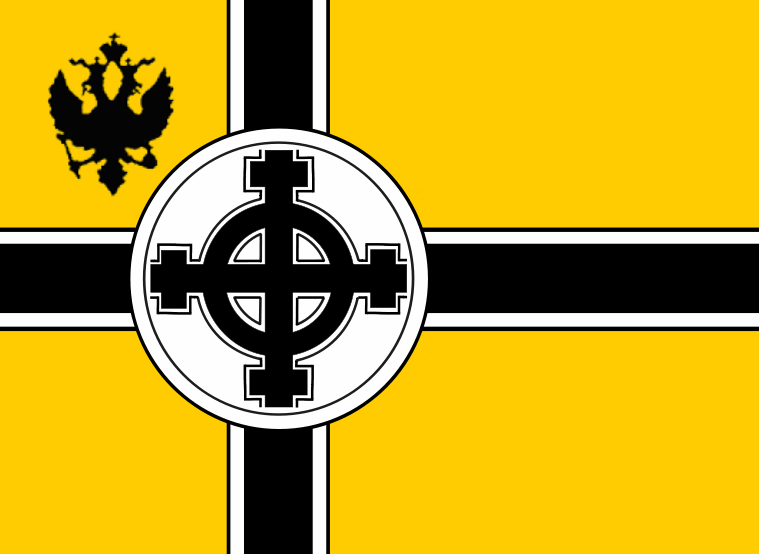
NFP Flag
Action Flag Type #1
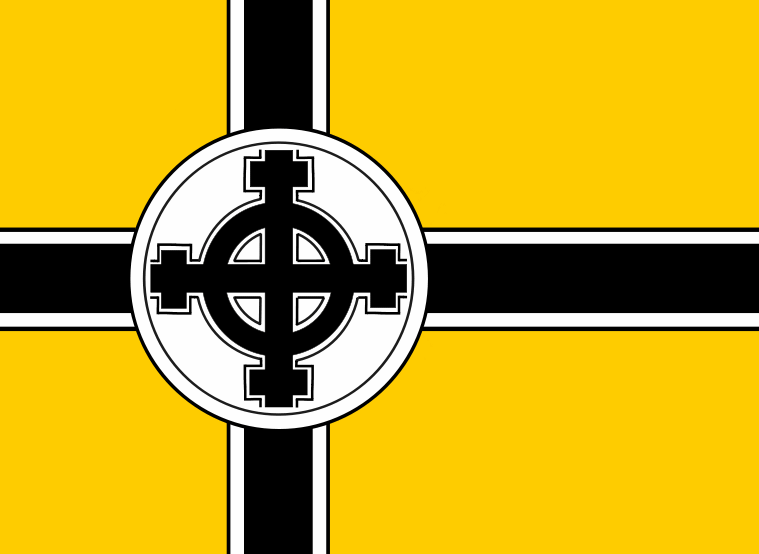
NFP Flag
Action Flag Type #2
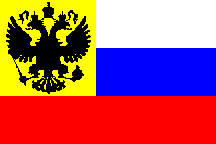 Imperial Russian State Flag 1914-1917 |
National Front Party (Russia)
These are flags used by a Russian neo-Nazi organization called the National Front. The National Front is led by Ilya Lazarenko. First formed in 1991 as the "Union of Russian Youth," then renamed the "Front of National-Revolutionary Action" in 1992, and finally named the "National Front Party" which it has remained since 1994. Its doctrine is racist and fascist envisioning a "Great National-Socialist Russian Empire" under a "national dictatorship," which explains their use of flags reminiscent of both Nazi Germany and Imperial Russia. When Lazarenko disbanded the FNRA in 1992, and founded the NFP, some of the members did not follow, but continued under the old name and it is assumed under old flag as well. The split was because some members insisted on following Orthodox Christianity in religious matters, while Lazarenko became follower of Russian neo-paganism and even formed a neo-pagan "church" together with the party. It is unclear what activities these that remained behind became involved with, or how long they lasted.
The National Front Skinheads wear traditional black fascist uniforms and display their black Celtic crosses on their banners which they claim are based on the crosses of Novgorod and Jerusalem instead of the traditional swastika which is illegal in Russia. According to Lazarenko, his movement has contacts with the Russian National Unity (RNE) of Alexander Barkashov, but the relations are generally cool because they view the policy of the RNE as "absolutely erroneous."
|
|
|
FNRA Flag
Action Flag Type #3 |
|
FNRA Flag
Action Flag Type #4 |
At demonstrations the National Front Party has been seen displaying flags using the traditional neo-Nazi red and white, but also flags using the Romanov Imperial colors (such as the Front of National-Revolutionary Action Flags - Type #1, Type #2, Type #3, and Type #4), and even re-purposing and using the last Russian Imperial State Flag of 1914.
It should be noted that the Front of National-Revolutionary Action Flag Type #4 has been reported as being used as a variant of the Front of National-Revolutionary Action Flag Type #3, but not well documented in photographs. |
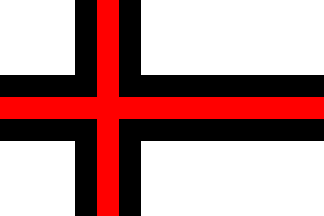
NKORP Flag
|
National Corporativism (Czech Republic)
Na'rodni' korporativismus
The neo-Nazi National Corporativism (NKORP) was founded in 2004. Its policies were mixture of nationalism, neo-Fascism and neo-Nazism doctrune. The membership base overlapped with other extreme right-wing groups, so it formed a kind of bridge between a legal political party the "Workers' Party" and the openly neo-Nazi "National Resistance." National Corporativism was gradually consumed by internal conflicts and in 2008 was shut down, and its leaders encouraged supporters to join the Workers’ Party.
Its flag was charged with a narrow red off-centred "Scandinavian" cross, with wide black borders, on white field. The general design not only employs the usual Nazi colors, but also vaguely resembles the Imperial German War Ensign. |

NL Flag
|
National List Party (Germany)
Nationale Liste (NL)
In 1989, various far-right neo-Nazis from Hamburg, led by Christian Worch and Thomas Wulf, founded the Nationale Liste (NL). The National List used this black flag with white inscription "NL" at their rallies and meetings. During the 5½ years of its existance the National List published a magazine that contained a list of names and addresses of left-wing and anti-fascist activists and organizations which led to attacks on some of the people listed.
In 1995, the NL was banned and its membership disappeared into other German extremist groups. |
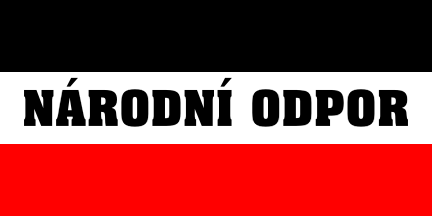
NO Flag
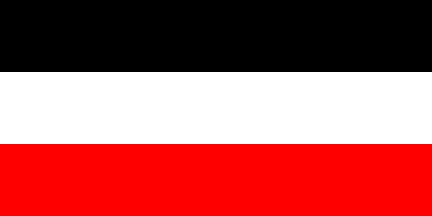
NO Flag
(alternate flag)
|
National Resistance (Czech Republic)
Na'rodni' odpor Praha
The National Resistance Prague (NO) was a short lived National Socialist group formed under the leadership of Filip Vavra and Jan Brcak in late 1998 who tried to organize public demonstrations against such things as broadcasting Radio Free Europe to Iran and Iraq, and free speech issues. In August of 1999, they organized a demonstration to pay tribute to the memory of Rudolf Hess, who they called the "last victim of World War II."
In October of 1999, although NO announced a demonstration at Arbesovo Square in Prague, their action was banned by authorities, and they joined a demonstration at Vitkov organized by the "Vlastenecka Fronta" (Patriotic Front) and the "Narodni Aliance" (National Alliance) instead. The demonstration ended mostly in chaos and with a small clash with police. The old National Socialist elite of the "Bohemia Hammer Skins" and "Blood & Honour" don't recognize NO and encounters between the groups often end with physical conflicts.
The NO flag was a black-white-red horizontal tricolor charged with the their name inscribed in black on the white field. The plain flag (without the inscription), was also used so frequently that it may be considered an alternate flag of the organization. |
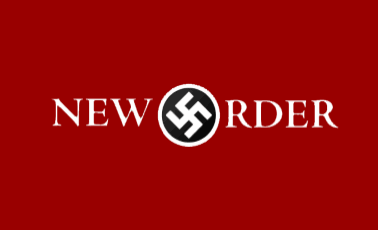
NO Flag
(questionable)
|
New Order (USA)
The New Order, founded by Matt Koehl in 1983, was the continuation of both the American Nazi Party (ANP) and the National Socialist White People's Party (NSWPP). It began when Koehl, George Lincoln Rockwell´s immediate successor, sold the ANP's real estate holdings in Virginia, and moved the NO headquarters to New Berlin, Wisconsin.
Today the NO claims that they are not a neo-Nazi political party, but rather a religious order which holds the memory of Hitler "in trust until such time when whites are ready to accept National Socialism as the only possible way to ensure Aryan racial and spiritual survival." The undocumented flag shown here appears to be the NO logo placed on a red field. |
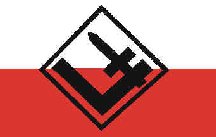
NOP Flag

NOP Green Variant
|
National Rebirth of Poland (Poland)
Narodowe Odrodzenie Polski (NOP)
The Narodowe Odrodzenie Polski (NOP) is a minor far-right, extremist nationalist political party in Poland. It is a member of European National Front. The NOP registered as a political party in 1992. It claims to be the reincarnation of National Radical Camp, the pre-war nationalist youth organization, which was banned in 1934.
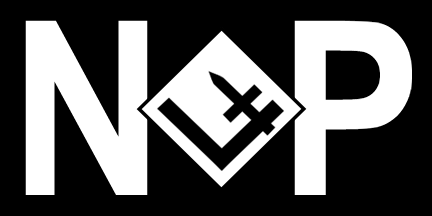
National Rebirth of Poland Variant
In 2001, NOP membership in Poland was estimated at 500, consisting mainly of neo-Nazi skinheads. In 2006, it received only 0.6% of the popular vote in regional elections. |
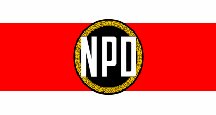
NPD Flag
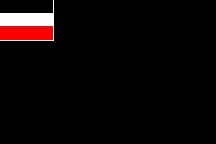
NPD Flag (Variant)
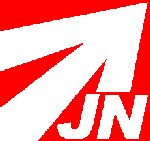
Young National Democrats Flag
|
National Democratic Party of Germany (Germany)
Nationaldemokratische Partei Deutschlands (NPD)
The neo-Nazi Nationaldemokratische Partei Deutschlands (NPD) was formed in the early 1960s when several right-wing parties merged and was rather successful in the elections during the 1960s, but lost most of its support in the early 1970s.
The NPD was founded in 1964 and has about 6,000 members making it the third largest right-extremist party in Germany. In 1969, it formed an youth organization called the Junge Nationaldemokraten (JN), or "Young National Democrats."
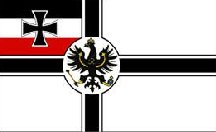 |
|
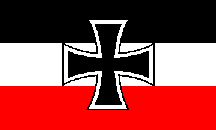 |
| Imperial War Ensign |
|
Imperial Naval Ensign |
The German Imperial Flags are prominently displayed by the NPD. These Imperial flags are displayed at party conventions and during demonstrations. NPD demonstrators wave different versions of these black-white-red flags. There are other modern variants of black-white-red that are produced by flag makers for right extremists and used by them. Because of this, not only are flags from the Third Reich banned, but many from the Second Reich era are now becoming banned, most notably the Imperial Naval Ensign and the Imperial War Ensign shown above. |
.gif)
NPF Flag
|
National Patriotic Front (Russia)
The National Patriotic Front, a splinter group from the Pamyat (Memory) Union, is a Russian ultra-nationalist organization sometimes identifying itself as the "People's National-Patriotic Orthodox Christian Movement." It has been accused of racism, xenophobia, and antisemitism.
The groups most well-known leader, Dmitry Vassilyev (who died in 2003), made the Pamyat Union the most prominent organized group of Russian nationalists in the 1980s. After several splits and name changes, and the imminent dissolution of the USSR, the organization launched its own newspaper "The Pamyat" in 1991, with print runs of 100,000 copies, and started their own radio station.
However, by the end of the 1990s, the original Pamyat had disappeared being replaced with smaller groups with names like "The National Patriotic Front" and "The Russian National Unity." The Russian National Unity promoted the cult of the swastika, a symbol which, they claimed acts on subconsciousness and paralyses, weakens and demoralizes non-believers." |
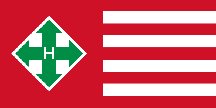
NPHM Flag 1935-1945
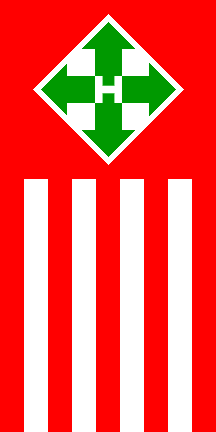
NPHM Vertical Banner
|
Hungarian Arrow Cross Party (Hungary)
Nyilaskeresztes Part-Hungarista Mozgalom
The Arrow Cross, or Cross Star, was a symbol used by the Arrow Cross Party and Nyilaskeresztes Part-Hungarista Mozgalom (NPHM), a national socialist pro-Nazi party led by Ferenc Szálasi, which ruled Hungary from October of 1944 to January of 1945. During the short rule, ten to fifteen thousand Jews were murdered outright, and 80,000 Jews were deported from Hungary to the Auschwitz concentration camp. After the war, Szálasi and other Arrow Cross leaders were tried as war criminals by Hungarian courts. Some Arrow Cross officials, including Szálasi himself, were executed. However, many Arrow Cross supporters were never prosecuted, and it is rumored that some may have found a new home supporting the Stalinist Rákosi regime.
|
|
|
|
|
Cross Star Flag - Type #1 |
|
Cross Star Flag - Type #2 |
|
Cross Star Flag - Type #3 |
The ideology of the Arrow Cross has resurfaced occasionally in recent years, the Neo-Fascist Hungarian Welfare Association being an example, however, it is very much a fringe element of modern Hungarian politics. Today, you will still see the Hungarian Arrow and Cross symbol used by non-Hungarian White Supremacist groups (see the Nationalist Movement below) and it is still used by some modern Hungarian neo-Nazi skinheads. |
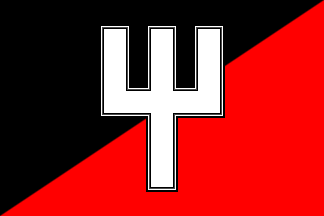
NR Flag
|
Nation and Revolution (Spain)
Nacio'n and Revolucio'n
The Nacio'n and Revolucio'n (NR) is one of many small ultra-rightist political parties now existing in Spain. Nation and Revolution first appeared in the general elections in 2008 using a flag diagonally divided in black and red, with a white trident outlined (fimbriated) in black and white in the center.
The trident symbol, although certainly not an excusive far-right symbol, has sometimes been used in various recognizable forms by other far-right groups in both Spain and Europe. A very similar example would be the current flag used by the Neo-Solidarist Alternative Movement in Belgium. |
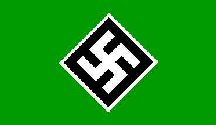
NSARL Flag
|
National Socialist Animal Rights League (USA)
A disturbing development that has emerged in some animal and environmental activist circles is the use of Holocaust imagery to promote their causes. This strange flag is being sold as an Nazi Animal Rights League flag.
Neo-nazi groups have also frequented animal rights demonstrations in an attempt to capitalize upon the tension and controversy generated by the issue. Many of them claim to subscribe to Adolf Hitler's original doctrine of a vegetarian, chemically untainted agrarian society in which vivisection is outlawed. |
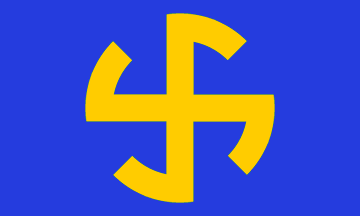
NSB (Sweden) Flag
|
National Socialist Bloc (Sweden)
Nationalsocialistiska Blocket
The National Socialist Bloc (NSB) was founded in 1933, but it never managed to achieve a large support and gradually vanished in early 1940's. The Party leaders were Colonel
Martin Ekström and Count Eric von Rosen.
The party used a blue flag charged with a yellow curved swastika. The color shades were those of the Swedish national flag at the time. The same swastika was also used as the NSB party emblem on their publications and posters. The flag was probably created by Eric von Rosen, himself, who used the swastika as a personal logo and also promoted its use in neighboring Finland. He is also credited for creating the original Finnish Air Force roundel with a blue swastika on a white disc. |
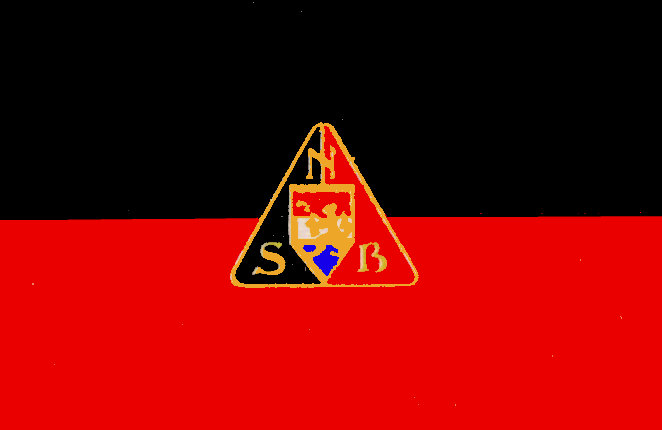
NSB (The Netherlands) Flag
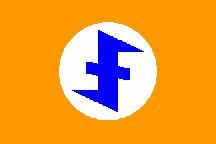
NSB Party Flag (Type #2)
|
National Socialist Movement in the Netherlands (Netherlands)
Nationaal-Socialistische Beweging in Nederland (NSB)
The Nationaal-Socialistische Beweging in Nederland (NSB) was a Dutch fascist and later national socialist political party. In 1941, it absorbed the other Dutch Nazi parties (like the NSNAP) and became the only one. The NSB wanted to unite the Netherlands and Flanders into a single German controlled country called "Dietsland." The NSB was the only legal party in the Netherlands during most of the Second World War.
The founder and leader of the "National Socialist Movement in the Netherlands" was Anton Mussert. The party based its program on Italian fascism and German National Socialism, however unlike the latter before 1936 the party was not anti-semitic and even had Jewish members. Beginning in the summer of 1943, many male members of the NSB were organized in the Landwacht, which helped the government control the population. In September of 1944, most of the NSB's leadership fled to Germany and the party's organization fell apart. After the German signing of surrender in 1945, the NSB was outlawed and many members of the NSB were arrested and convicted, including Mussert, who was executed in 1946.
After the NSB was founded in 1931, one of their flags used the colors of the Dutch tricolor (the field was orange, with on a white disc and the blue rune sign of the wolfsangel [wolf hook] centered on it), and the other was a black-red horizontal bicolor charged with a triangular-shaped emblem featuring a red-white-blue shield with the Lion of Flanders centered upon it and surrounded by the party initials of "NSB." |

NSCP Flag
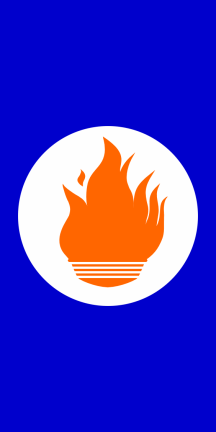
NUPC Vertical Banner
|
National Socialist Christian Party (Canada)
Parti National Social Chrétien (PNSC)
The National Socialist Christian Party (NSCP), founded in Quebec, used a blue flag charged with a red swastika in a white disk between 1933 and 1938. Adrien Arcand (died 1967), the would be "fuehrer" of Canada, led various National Socialist movements during his lifetime, and he and his followers used a variety of similar flag designs over the years. The party platform supported anti-semitism, the doctrines of Adolf Hitler, and teachings of Nazism. Arcand's party eventually joined with other Canadian far-rightist groups to form the Parti unité socialiste nationale canadienne (Canadian National Socialist Unity Party), or more commonly known as the Parti de l'Unité nationale du Canada (National Unity Party of Canada or NUPC).
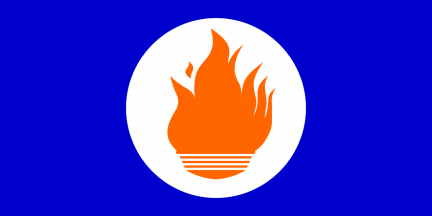 Canadian National Socialist Unity Party The National Unity Party of Canada, sometimes referred to as the 'Blue Shirts' after their paramilitary uniforms, commonly attacked immigrants, minorities and leftist groups. Although the NUPC boasted that it would seize national power in Canada, it had little support outside of Quebec, British Columbia, and Alberta. During World War II the party was banned under the War Measures Act, and Arcand and many of his followers were arrested and detained for the duration of the war. The NUPC still exists today and Arcand's disciples still lurk on the extreme right wing of Canadian society.
Their original flag (and arm band) featured a red swastika in a white disk on a blue banner patterned after the German Nazi banner. Their later flags substituted an orange torch issuing from a striped bowl for the original swastika symbol. Their logo, not used on a flag, also featured the orange torch, but it is bordered by maple leaves and topped by a beaver in profile. |
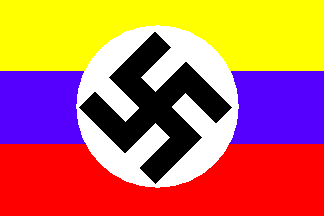
NSE Flag
|
Ecuadorian National Socialism (Ecuador)
Nacional Socialismo Ecuatoriano
The National Socialism Ecuatoriano (NSE) is a neo-Nazi, racist, right-wing conservative group in Ecuador with possible ties to the Legión Blanca (White Legion), a shadowy right-wing organization in Ecuador that is responsible for numerous death threats since 2001 to politicians, human rights workers and left-wing activists in the country. In addition, the group claimed responsibility for a March 2003 arson attack on the Ecuadorian Congress building which caused a large amount of damage, but no casualties. No arrests were ever made in the arson. Further, the White Legion has not claimed responsibility for any attacks since the March 2003 arson, and reports of death threats from the group have all but ended since October of that year. |
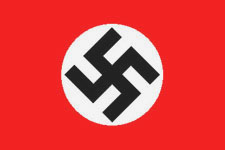
Original NSDAP Flag
|
National Socialist German Workers Party (Germany)
Nationalsozialistische Deutsche Arbeiterpartei (NSDAP)
The Nationalsozialistische Deutsche Arbeiterpartei (NSDAP), commonly known in English as the Nazi Party, was a political party in Germany between 1919 and 1945. It was known as the Deutsche Arbeiterpartei (German Workers' Party - DAP) before the name was changed in 1920.
The party policies included dictatorial powers for the party leadership, fanatical nationalism, and racial hatred. Nazi sponsored death camps resulted in over 12 million deaths. The party's last leader was Adolf Hitler.
Neo-Nazis groups around the world have created many variations on the flags of Nazi Germany over the years, often because Nazi flags themselves are banned in a number of countries. Some variations involve modifying the swastika to some degree, while others replace the swastika with an alternate white supremacist symbol such as various runes used in Nazi Germany. |
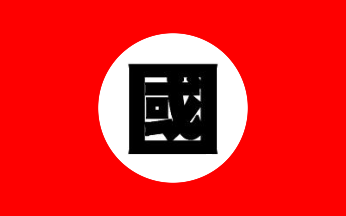
NSP-J Flag
On their Nazi-like flag the symbol of the swastika was replaced with the Japanese character of kuni (country). |
National-Socialist Party of Greater Japan 1934-1937 (Japan)
Dai Nippon Kokka Shakai Tou
In 1932, Katsumaro Akamatsu founded the Japanese National-Socialist Party (Nippon Kokka Shakai Tou), which was merged into the National-Socialist Party of Greater Japan (Dai Nippon Kokka Shakai Tou) under the leadership of Junjuro Ishikawa in 1934. Ishikawa was the author of the book "Research on Hitler's Mein Kampf," which glorified the Nazi doctrine. Their general platform was typically racist, and against both the capitalism and communism of their time. However, the use of the term national socialism, in Japan, is difficult because it never remained a truly independent political philosophy, but instead became a collection of elitist, conservative and quasi-fascist ideals which were used by the Japanese political leadership for their own purposes.
In 1936, young Japanese military officers influenced by their Japanese National Socialist leader Ikki Kita, attacked the Prime Minister's residence, and other governmental offices, killing the Minister of Finance, the Ministry of Home Affairs, the Superintendent General of Military Education, and other officials. They purposed to establish a National Socialist military regime to reform the state, instead, Kita was captured, sentenced to death, and executed in 1937, thus effectively ending this early national socialist movement. |

NSJWP Flag
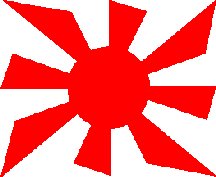
National Socialist Movement
|
National Socialist Japanese Workers and Welfare Party (Japan)
Nationalsozialistische Japanische Arbeiterpartei (NSJAP)
The Nationalsozialistische Japanische Arbeiterpartei (NSJAP) is a far-right Japanese political party that campaigns on a platform of National Socialism. Founded in 1982, the party is also known as "New Axis Party." The party celebrates the empire of Japan and its alliance with the Third Reich. The party believes in a return to the Shogun system as an indigenous take on National Socialist principles of leadership. It is virulently anti-Semitic, and believes in an international Jewish conspiracy employing Freemasonry to control Japan. Today, it is known as the National Socialist Movement, and it is not a significant force in Japanese politics.
The New Axis Flag uses a pinwheel type of swastika which is a variation on that used by many racists organizations and individuals. The National Socialist Japanese Workers and Welfare Party also has been known to use a variant of the old Tohokai Party Flag.
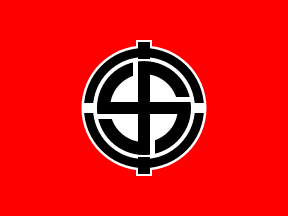 |
|
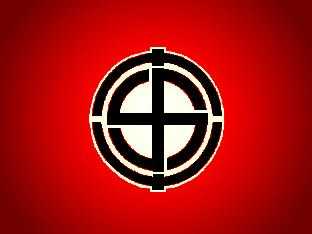 |
| The Tohokai Party Flag |
|
Modern Variant Flag |
|
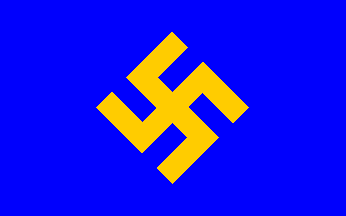
NSF 1994
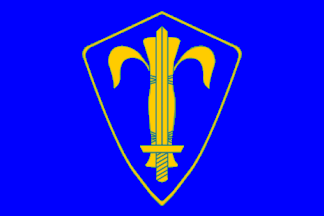
NSF 2006
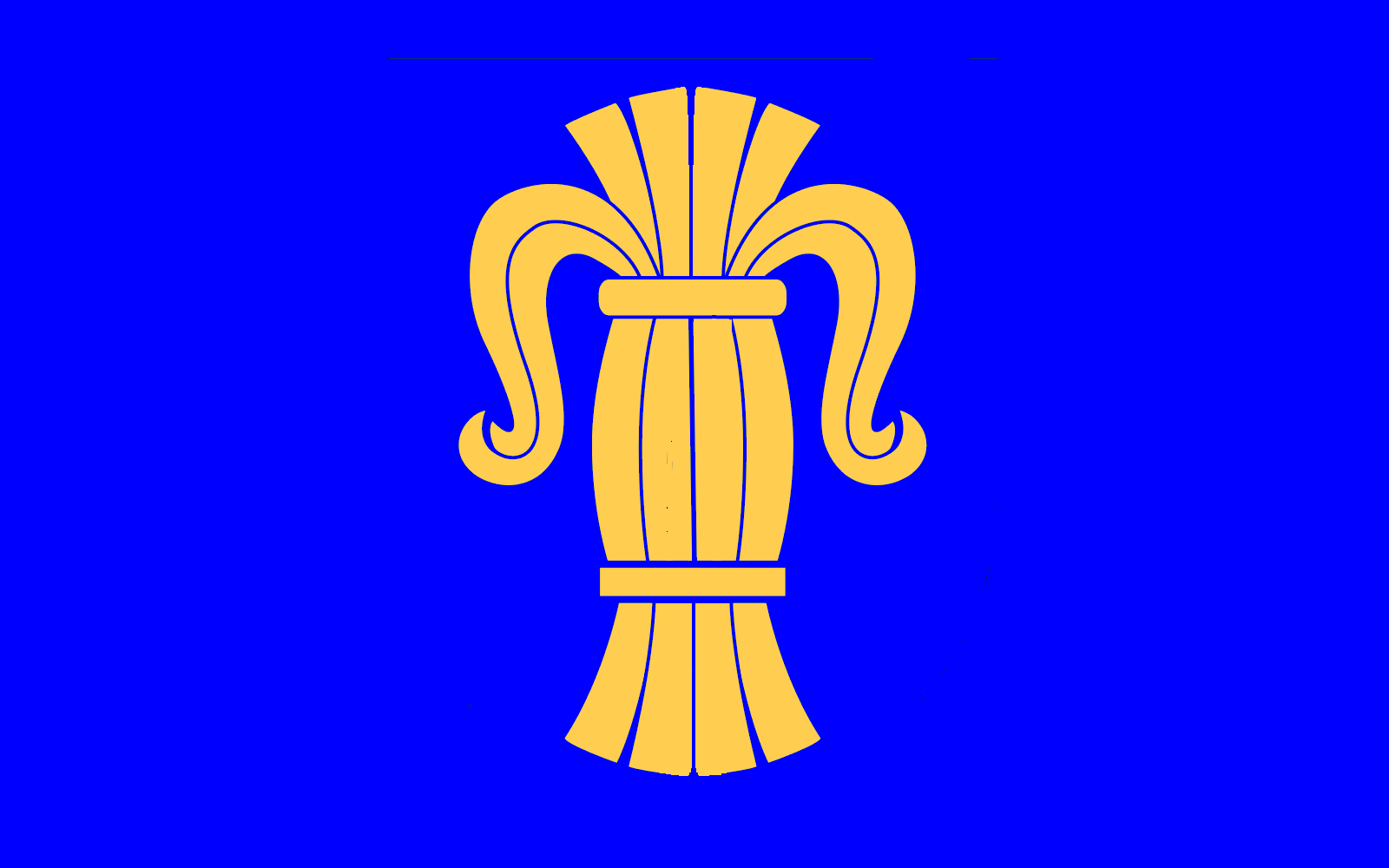
NSF 2008
(image not accurate)
|
National Socialist Front 1994-2008 (Sweden)
Nationalsocialistisk Front (NSF)
The Nationalsocialistisk Front (NSF) was a Swedish neo-nazi political party. The organization was founded in 1994 in Karlskrona. On the birthday of Adolf Hitler, April 20, 1999, the NSF became a registered political party. In 2008, at the time of its dissolving, the NSF was the largest Neo-Nazi political party in Sweden. A new party was founded to replace it, the People's Front (Folkfronten) with the same people in charge.
The party had as its main goals the abolition of democracy, the repatriation of immigrants, the implementation of scientific racism and cutting taxes for families with many genetically healthy children. The NSF traced its heritage back to a World War II era National Socialist party. The original World War II NSF flag had a red swastika on a gold circle on a blue flag.
In the NSF's new reincarnation the red swastika was changed to gold. During political demonstrations the members wore a black combat shirt, black military-cap, boots, khaki-coloured combat pants, and wore the party's logo on a arm band. This uniform was outlawed by the police in 2006, it was considered a hate crime just to wear them during demonstrations. After that the members of the party often wore a simple blue t-shirt with the gold letters "NSF" on them. The swastika was replaced on their flag with a shield, charged with an upright sword superimposed on a stylized wheat sheaf. The sheaf emblem, originally the symbol of Vasa royal dynasty, was and still is used by many other Swedish ultra-rightist groups."
In 2008, a new variant of the "wheat sheaf" flag was seen used by the National Socialist Front in their last demonstrations in Karlskrona before they disbanded and metamorphosed themselves into the People's Front. This new variant featured an enlarged "wheat sheaf" symbol and the removal of the inner sword and the outer shield outline. |
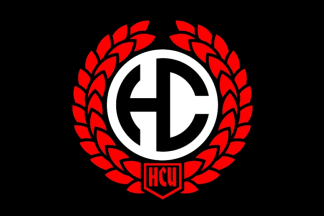
NSI Flag Type #1
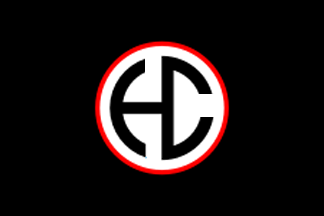
NSI Flag Type #2
|
National Socialist Initiative 2009 (Russia)
Natsional'naya Sotsialisticheskaya Initsiativa
The ultra-right National Socialist Initiative (NSI) was formed in St. Petersburg in 2009 by Dmitri Bobrov, nicknamed Shul'ts, but since then has spread to other locations such as the city of Cherepovets. Bobrov was originally the leader of an informal group of Nazi skinheads called Shul'ts-88, which were active in St Petersburg and the Leningrad Region (2001-2007) before the police suppressed them. Bobrov himself was arrested in December of 2005 and sentenced to six years in jail on a conviction of violence as the leader of the Schulz 88, but was released in 2009. After that, he founded the National Socialist Initiative.
In 2010, the National Socialist Initiative Group in the City of Cherepovets, in the Vologda region, was deemed extremist by the Vologda City Court in May of 2010. The NSI appeared first in the city in the beginning of 2010 as a regional branch of the movement of St. Petersburg. The group, following the lead of Dmitry Bobrov, has taken part in mass brawls and committed violent crimes. Recently, the NSI has attempted to join public, non-nationalist actions organized by other movements, with the goal of bursting onto the field of public politics by demonstrating that a "unified nationalist front" exists that supports the concept of "Russia for the Russians."
The sunwheel-like device used in the center of the NSI flag is based on the Cyrillic monogram "NS." The abbreviation "NSI" appears on small shield in bottom part of the whole device on flag type #1. The initials of the National Socialist Initiative (NSI) are the same in Russian and English. |
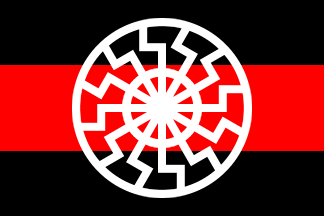
Black Sun Flag
|
National Socialist Revolutionary Movement "Black Sun" (Russia)
Natsional-sotsialisticheskoye revolyutsionnoye dvizheniye "Chornoye
Solntse"
The National Socialist Revolutionary Movement, or Black Sun, is a small Russian neo-Nazi organization that not much is known about. The NSRM flag is a black-red-black horizontal triband, with the red stripe a bit wider than the black ones. It has a large Black Sun symbol in white centered on the flag. The symbol looks like the mirror-image of
its usual depiction.
All currently available photos of this flag date from 2016, so the organization must have been founded earlier that year or shortly before, and the same applies to introduction of its flag.
Additional information about the Black Sun symbol can be found here. |

NSM88 Flag
|
National Socialist Movement - Russian Division (Russia)
Natsional-sotsialisticheskoye Dvizheniye-Russkiy Divizion
Other than this flag of the "National Socialist Movement - Russian Division," little else is known, which indicates a very small organization. They did have a website, all in Russian, and were affiliated with the National Socialist Movement (USA).
The Russian Division used this red flag with a large white disc, charged with a variant of the wolfsangel symbol in black. The image of this flag could be seen at the movement website which, as mentioned, is no longer available online. We suspect the movement probably disbanded itself, the members leaving to join other similar organizations, of which, there seem to be no shortage of presently in Russia. |
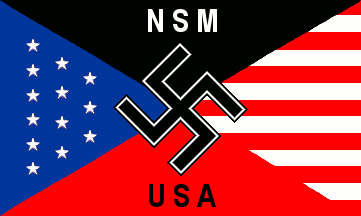
NSM Flag with Text
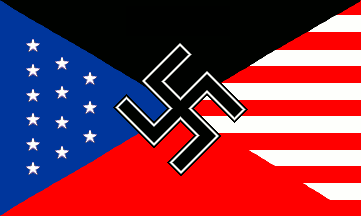
NSM Flag without Text
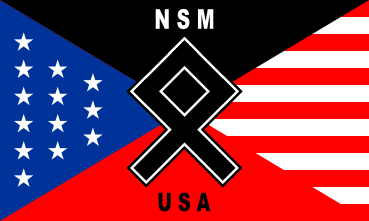
Odin Rune Flag with Text
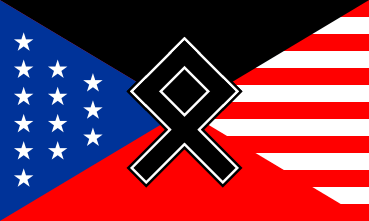
Odin Rune Flag without Text
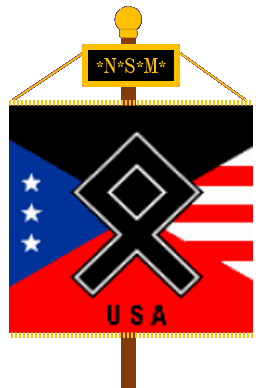
Odin Rune Ceremonial Banner
|
National Socialist Movement Flag (USA)
The National Socialist Movement (NSM) is currently one of the largest neo-Nazi group in the United States. The NSM promotes its anti-Semitic and racist ideology at rallies throughout the country, particularly in the Midwest, and through the group's website, internet-based radio programs, white power music companies and video games. Members wear Nazi uniforms and openly display swastikas to a degree unusual even among white supremacists.
The party was founded in 1974 as the "National Socialist American Workers Freedom Movement" by Robert Brannen and Cliff Herrington, former members of the American Nazi Party (ANP)before its decline. The party's chairman is Jeff Schoep, who has held that position since 1994. Although classified as a hate group by the Southern Poverty Law Center, it refers to itself as a "white civil rights organization."
Prior to the introduction of a special flag for the NSM, the group commonly used the traditional National Socialist German Workers Party (NSDAP) flag. However, with the adoption of the name "National Socialist Movement" its leaders apparently felt a new and unique "Americanized" flag was necessary.
There seems to be two variants of the National Socialist Movement Flag in use. The most common variant has the letters "NSM" above the swastika on the black background area and "USA" below it on the red background area.
A second variant of the NSM Flag doesn't have the lettering. It was reported in use in Leith, North Dakota, where the NSM was trying to establish a "white homeland".
Another newer variant of the NSM flag seems to have appeared in late 2016, but was not much in use until displayed at the Charlottesville Riots in 2017. On the new variant they seemed to have replaced the swastika with a Odal Rune, sometimes referred to as "Odin's Rune." Its a symbol of a Pagan Religion called Odinism and a favorite of many modern extremist hate groups.
The rune has double fimbriation, the inner in white and outer in black, as did the swastika on original flag. The inscriptions "NSM" in white on the black field and "USA" in black on the red field also appear on the first variant, although obviously they are omitted on the second. There also seems to have been a slight change in fonts styles and text sizes on the newer reported "Odin's Rune." flags.
This newer variant National Socialist Movement design in the form of a vexillum has reportably migrated to the NSM ceremonial banners following the traditions of the SA (Sturmabteilung) Standards of the late 1920s and early 1930s, and the modern American Nazi Party.
The SA was a paramilitary organization created to protect Nazi meetings and disrupt those of other parties. Their standard usually hung from a wooden cross bar slipped through a cloth tunnel formed at the top of the standard which in turn was hung from the top of the flag staff (pole) and carried by Hitler's elite Stormtroopers or Brown Shirts. They were an early militia of the National Socialist German Workers Party (NSDAP).
The National Socialist Movement banner, or vexillum, has their stylized U.S. flag as its field, but with only three white stars showing perhaps representing the Three percent Movement, but more likely a result of giving the normal rectangle flag a square shape, with the Odal rune symbol in the middle. Reports of the finial on top varies from an eagle to a ball. Yellow-gold tassels and fringe surround the ceremonial vexillum.
|

NSM Britannia Flag
(black lettering)
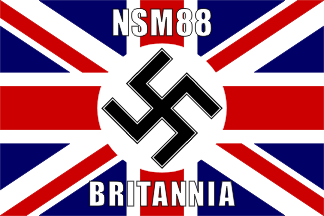
NSM "88" Flag
(white lettering)
|
National Socialist Movement - Britannia (UK)
There were two groups calling themselves the National Socialist Movement in the United Kingdom, one group (NSM Britannia) formed in 1962 by Colin Jordan as a splinter group from the British National Party, and the other (NSM 88 United Kingdom), dating from 1997, formed by David Myatt who split from the earlier British neo-Nazi group Combat 18. Both groups used variants of the defunct Imperial Fascist League flag. There doesn't seem to be any connection between the two splinter groups, except their neo-Nazi extremist and racist beliefs and their names. The group formed by Colin Jordan tried to organize an armed wing called Spearhead, but was shut down by the police and the membership fled to other extremist groups.
The newer of the two groups taking up the banner of the NSM in the United Kingdom formed when the original leader of Combat 18, Charlie Sargent, was charged for murdering fellow C18 member Chris Castle. Sargent's brother Steve Sargent, together with David Myatt, formed the new National Socialist Movement, sometimes referred to as NSM88, in June of 1997. The NSM was not widely known until in 1999 when NSM member David Copeland, known as the London nail-bomber, received six life sentences for his murderous bombings of London's black, Asian, and gay communities that killed three and injured 127 more people.
Today, under the leadership of a "Corporal John," the NSM88 website claims they are "...defending the rights of white people everywhere, preservation of our European culture and heritage, strengthening family values, economic self-sufficiency, reform of illegal immigration policies, immediate withdrawal of our national military from an illegal Middle Eastern occupation and promotion of white separation." |
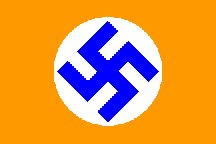
NSNAP Party Flag
|
National Socialist Dutch Workers Party (Netherlands)
Nationaal-Socialistische Nederlandsche Arbeiderspartij (NSNAP)
The Nationaal-Socialistische Nederlandsche Arbeiderspartij (NSNAP) was a minor Dutch national socialist party founded in 1931 and led by Ernst Herman van Rappard. Seeking to copy the fascism of others, notably Adolf Hitler, the group failed to achieve success and was accused by rivals of being too moderate for a fascist movement. It was absorbed by the more aggressive NSB in 1941.
The group looked to the National Socialist German Workers Party for its inspiration, setting up its own Storm Trooper battalion in imitation of the Sturmabteilung and its own Holland Youth like the Hitler Youth. The NSNAP sought full incorporation of the Netherlands into the Third Reich. |
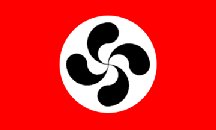
MNSE Flag
Fictitious Flag

Swastika National Socialist Flag
Fictitious Flag
|
National Socialist Movement of the Basque Country (Spain)
Movimiento Nacionalsocialista de Euskalherria
A series of flags were posted on websites to apparently bring into disrepute legiment Basque nationalists movements by attempting to connect them to the Nazi National Socialist movement. The Basque National Socialist Party of the Basque Country doesn't exist. The Lauburu symbol is, however, among the traditional symbols used by the Basque people. The non-existant Movimiento Nacionalsocialista de Euskalherria (National Socialist Movement of the Basque Country) claimed this flag, that uses the Lauburu in lieu of the Nazi swastika, as their flag. They called it the "lauburu o esvástica vasca" (Lauburu or Basque swastika), and say it represents their National Socialist movement in Spain.
Other fictitious flags claiming to be the flags of the National-Socialist Movement of the Basque Country have also been placed on the internet. As far as can be determined none of these flags or a National Socialist Party actually exists in the Basque Country.
The "arrano beltza" (black eagle) is also usually shown on Basque independentist flags, but has nothing to do with the National Socialist Movement. |
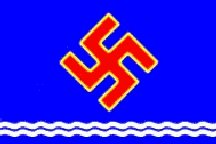
NSPC Flag
|
National Socialist Party of Canada (Canada)
The National-Socialist Party of Canada (NSPC) is a small neo-Nazi group that claims to "support Canada as an independent and indesoluable nation of white citizens sovereign in its own living space." They hope "to implement what they call the "Seven Points of National Socialism" in Canada and to implement a proposed National Socialist Constitution for Canada. The NSPC was founded in 2006, is organized in secret semi-autonomous cells, but claims 250 members. Terrence Cecil Tremaine is the NSPC founder and national director. They admit to being a racialist organization, and claim that many of their members are also active in Stormfront-Canada.
Their flag shows a red swastika rising over ocean waves, which they claim represents the "radiant Sun of National-Socialism" rising over the "Ocean of the People" bringing energy, light, idealism and racial health. |

NSAFP Flag
|
National Syndical American Falangist Party Flag (USA)
The National Syndical American Falangist Party (NSAFP), also called simply "The American Falange," was founded in 1985, seemed to share most of the beliefs of the original Spanish Falangist (Fascist) Party, although some of the party's beliefs, like the right of every citizen to own "fully automatic assault weapons" could only have been born in America. The Falangists believed in the power of the worker, but also had strong bias against Muslims and homosexuals.
The NSAFP disbanded in 2000, but their website is kept up for "historical purposes," and many of their former members went on to join the Christian Falangist Party of America. (Note: The flag of the Venezuelan Phalanx is almost identical to that of the NSAFP.) |
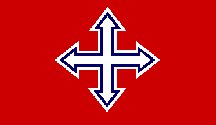
NM Flag
|
Nationalist Movement Flag (USA)
The Nationalist Movement is a Mississippi-based, white supremacist organization that advocates what it calls a "pro-majority" position. It has been called white supremacist by the Associated Press and Anti-Defamation League, among others. Its leader is Richard Barrett and its Secretary is Barry Hackney. Its activities include its Warrior-Training Camp, Unixandria Library, the Crosstar website, Prisoner Pen-Pal Club, "All The Way" newspaper, Free-Tip news-service, Crosstar Forum, Airlink television-studios and Nationalist Legal-Defense Fund. The symbol of the movement is called the "Crosstar," which originated in Hungary. |
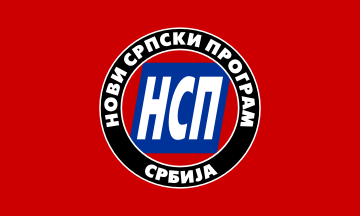
NSP Flag
|
The New Serbian Program (Serbia)
Novi srpski program
The New Serbian Program was founded in June of 2008 as an attempt to establish a legal ultra-rightist organization in Serbia. Successfully registered, it was meant to be a legal cover for the activities of the National Formation (NF), which was under legal sanctions at the time. Although NF leader Goran Davidovic, and many of his closest followers, joined the NSP, it engaged in less violent actives than its direct predecessor in its attempts to appear more legitimate. In 2010, an internal conflict over a member who, according to the NSP website, "betrayed his race" by having a close relationship with a "non-Aryan" looking woman (photographed together at a music festival), divided the membership to such an extent, that the NSP was disbanded.
The flag of NSP was red with the emblem in center, consisting of white Cyrillic initials NSP on a blue rhomboid which is surrounded, and partly covered, with a black ring fimbriated white and charged with names of the organization and the country, also in white. |
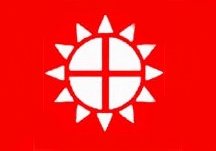
NPC Flag
(unverified)
|
Nationalist Party of Canada (Canada)
The Nationalist Party of Canada (NPC) is a white supremacist political party that was founded by Don Andrews in 1977 in Toronto. The goal of the party is "the promotion and maintenance of European Heritage and Culture in Canada." The Nationalist Party evolved from another white supremacist organization, the Western Guard, as a result of Andrews being legally barred from the Western Guard. From 1977 to 1985, the party published the "Nationalist Report," which ceased publication when Don Andrews and Party Secretary Robert Smith were both charged and convicted under the Criminal Code of Canada for promoting hatred.
Still based in Toronto, the NPC continues to further its goals through supporting such projects as European Heritage Week, a shortwave radio program, and running for office in local elections. Don Andrews has run for Mayor of Toronto several times, including in 2003 when he won 0.17% of the vote. In that year, two other party members ran unsuccessfully for the Toronto City Council. |
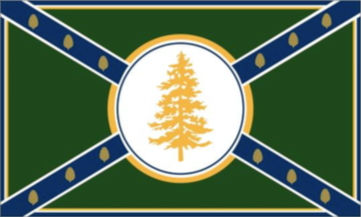
New Albion Flag
|
New Albion (USA)
Racism raises its ugly head in many places, but it is unusual when its source was apparently hired by a town council. Amid the rise of the alt-right and the resurgence in the United States of white nationalist movements encouraged by the election of President Donald Trump, the town of Jackman, Maine, has hired as town manager, Tom Kawczynski, the leader of the New Albion movement. The town of Jackman is a small New England town located in Somerset County near the Canadian border. The New Albion movement, founded by Kawczynski, claims that Islam is "the scourge of Western civilization" and suggests that the United States would be better off if people of different races "voluntarily" separate themselves from the United States. Kawczynski rejects the idea that his views are racist, but is opposed to the idea of allowing people into the United States that come from cultures not "rooted in Western civilization."
The flag of the New Albion movement features an encircled gold pine tree emblem centered over a blue Confederate-style cross/saltire where the symbols of gold pine cones replace the stars of the Confederate battle flag. |
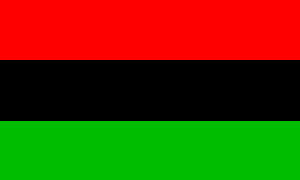
NBPP Flag
|
New Black Panther Party (USA)
The New Black Panther Party (NBPP), whose formal name is the New Black Panther Party for Self-Defense, is a black political organization founded in Dallas, Texas, in 1989. Despite its name, NBPP does not appear to be an official successor to the original Black Panther Party. Both the Anti-Defamation League and the Southern Poverty Law Center have classified the New Black Panthers as a hate group.
The New Black Panther Party commonly makes use of the red-black-green tricolor flag of the Black Liberation Movement of the 1920s. The flag was also used by the original Black Panther's Party during the 1960s. See the "Black Liberation Flag" on "Modern American Protest and Message Flags" page for more information on the original flag. |
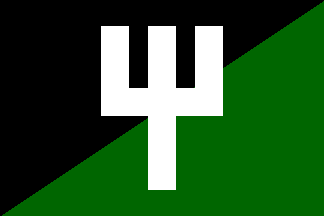
N-SA Flag
|
Neo-Solidarist Alternative Movement (Belgium)
Nieuw-Solidaristisch Alternatief (N-SA)
The Nieuw-Solidaristisch Alternatief (N-SA) is an ultra-rightist movement founded on the model of the German NPD, aiming at attracting the various Flemish ultra-rightist movements currently not represented in the Parliament. The leader of the party, Edouard Hermy, has a long political history linked to the Flemish extreme-rightist movements. In 1999, he was expelled from the ultra-nationalist party Vlaams Blok (VB) for his extreme racist beliefs. Since that time a number of members of the VB have left it, deeming it "not radical enough," to join the N-SA. The leaders of the VB have not actually forbidden their members to join N-SA, but have advised them not to do it. |
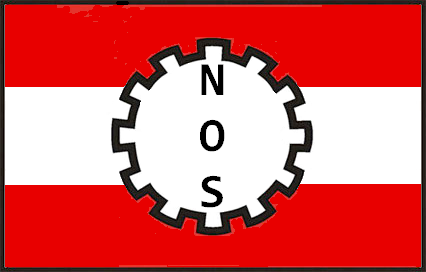
NOS Flags
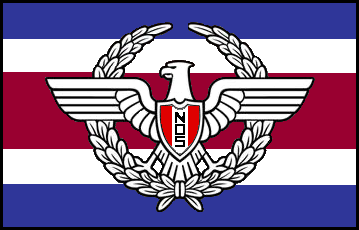
|
New Social Order Flag (Costa Rica)
Nuevo Orden Social (NOS)
The Nuevo Orden Social (NOS) is a self proclaimed militant group of Costa Rican working and middle class socialists whose aims are "...to preserve and restore the essence of the nationalist spirit in our country, erected in practical example of our socialism ideas" and are "opposed to the current political system which has been ruling to us for decades with its familiar pathological corruption and incompetence."
According to the New Social Order the red color on their flag represents all those who have died for Costa Rica, the white represents the peace which they feel has been gradually lost. The gear-shaped Social Symbol stands for work and progress. They claim the "New Eagle" on the second flag, with its New Order "Social Shield," protects and enforces the peace and freedom of the Costa Ricans by remaining vigilant to any threat. The new Eagle was placed on the Costa Rican national flag to represent the New Order's aspiration to forge in Costa Rica a small, but great empire, a homeland of respect, order, discipline and socialist values.
The New Order remains an extremely nationalistic movement whose goal is to overthrow the current government and see themselves as the leaders of a future Costa Rican empire. |
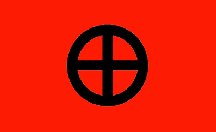
NRP Flag
(Sun Wheel variant)
|
Nordic Reich Party Flag (Sweden)
Nordiska rikspartiet (NRP)
The Nordiska rikspartiet (NRP) is a Neo-Nazi political party in Sweden, founded in 1956 as the Sveriges nationalsocialistiska kampförbund (National Socialist Struggle League of Sweden) by Göran Assar Oredsson. Oredsson was the also the party leader except for a few years during the 1970s when he wrote his autobiography Prisat vare allt som gjort mig hårdare ("Blessed be everything that has made me harder"). During that time, his wife Vera Oredsson took on the role as party leader and became Sweden's first woman who ever been a party leader.
In 1973, NRP ran for the Swedish parliament but only obtained a few hundred votes. |
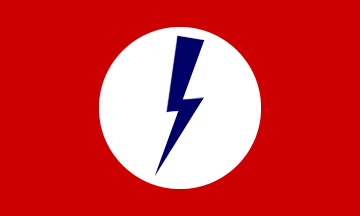
NRP Flag

NRP Flag
(vertical variant)
|
National Renaissance Party 1949-c1980 (USA)
In 1949, the National Renaissance Party was founded in Yorkville, a part of New York City, and soon was under the control of a fanatical public accountant named James Hartung Madole. The original party membership seems to have transferred from older nationalist groups such as the Christian Front, German-American Bund, Citizens Protective League, and the Nationalist Action League.
The NRP activities remained fairly localized to the New York City area, though occasionally reaching out to the Reading and Philadelphia areas of Pennsylvania. The NRP communicated its beliefs through a party publication named the National Renaissance Bulletin, which was edited by Fred Weiss. The NRP party membership was normally about 50 and never exceeded 200.
In 1953, the party added a uniformed "Elite Guard" (EG) to its organization under the leadership of Matt Koehl and Hans Schmidt. The Elite Guard members wore black pants and gray shirts, with a red lightning bolt armband (blue bolt on white circle). Normally, the EG had only about fifteen or twenty active members.
In the 1960s and 1970s the party seems to have became occult oriented and involved in mysticism; developing ties with Anton LaVey and the Church of Satan. Madole died of cancer in 1979, and the party disbanded soon after.
The NRP used as a symbol a thunderbolt. Their flag, as well as their armbands, had a solid-red field with a blue thunderbolt on a white circle. The flags existed in both horizontal and vertical formats.
|

NSALP Flag
|
National Socialist American Labor Party (USA)
The National Socialist American Labor Party split off from the National Socialist Movement of America. They describe themselves as "an orthodox National Socialist Political Party designed to move National Socialism into the active political process." They claimed to demand "commitment and devotion to the principals of the National Socialist American Labor Party and to the National Socialist World View as set forth by Adolf Hitler."
The NSALP flag was a simple red flag with the party's logo centered on it. |
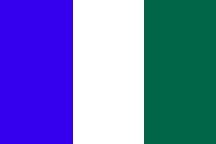
NWHL Flag
|
Northwest Homeland (Northwestern Front) Flag (USA)
This is the flag of a very small far-right group calling themselves the Northwest Homeland. They are also known as the Northwest Migration project, and more recently the Northwestern Front. They want all pure white people to migrate to the Pacific Northwest of the United States. They do this to resist what they call "ethnic cleansing," encourage their members to obtain firearms and learn to use them, and feel that within a century white people will become extinct worldwide unless they consolidate in the Pacific Northwest homeland.
This flag is a good example of how harmful racial meanings can be hidden in fairly harmless looking flags that can be displayed openly without causing comment. Most uninformed people would not notice this tricolored flag, or read anything sinister into it. |
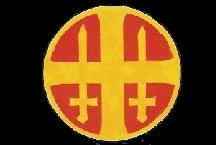
NS Rikshird Flag

NS Rikshird Flag
(black & white variant)
|
Norwegian National Union Party (Norway)
Nasjonal Samling
In the same year that Adolf Hitler came to power in Germany (1933), Vidkun Abraham Lauritz Quisling formed the Nasjonal Samling, or National Union (Unity) Party in Norway. This party was styled after the German National Socialists under Hitler, and after the Germans invaded Norway became the only Norwegian party to be supported the Germans. Quisling assumed power as the new leader of Norway.
The Hird, or Rikshird, was a Norwegian form of the German SA or Storm Troopers. A loose translation of the ancient Norse hird would be "national or state follower." This black flag with a gold and red sun cross with upward pointing swords upon the two horizontal branches of the sun cross, was used by Rikshird collaboration forces during World War II, and is also in use today as a Neo-nazi symbol.
During the German occupation, each regiment in the Rikshird that used a flag would also have a specific emblem or the location of the regiment on the upper right quarter of the flag. |
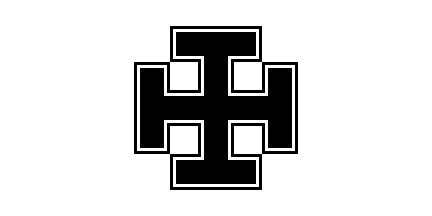
NNP Flag
|
People's National Party (Russia)
Narodnaya Natsional'naya Partiya (NNP)
The Narodnaya Natsional'naya Partiya (NNP) is a small far-right neo-Nazi political party. Their ideology, called Russism, is a "localized" form of Nazism that believes in the creation of an all-white Russia, and eventually a Russian-led white Europe. Its leader is Aleksandr Ivanov-Sukharevsky, who founded the party in 1994, and racist skinhead leader Semyon Tokmakov has served as deputy leader of the party.
The party flag is white with a large black cross in the center (two swastikas, one right-facing and one left-facing). The People's National Party consists largely of white power skinhead youths, whose members wear a white shirt with a black armband bearing their black cross. |

NSRP Flag
|
National States Rights Party 1958-1987 (USA)
The National States´ Rights Party was a far right, white supremacist party that was founded in 1958 in Knoxville, Tennessee. The party preached antisemitism, racism and opposed the American civil rights movement. The national chairman of the party was J. B. Stoner, who served three years in prison for bombing a Baptist Church in Birmingham, Alabama. The party produced a newspaper, The Thunderbolt, which was edited by Edward Reed Fields, and claimed a circulation of 15,000 in the late 1960s. The party began wearing Nazi inspired party uniforms with white shirts, black pants and tie, and an arm band bearing a red thunderbolt version of the Wolfsangel. They were soon connected to bombings, violence, and inciting riots. In the 1980s the Federal Bureau of Investigation labeled the NSRP as a hate organization, and by 1987 it had ceased to exist altogether.
Although the NSRP flags varied slightly since most of them were hand-made, the flag design was clearly based on that of the Confederate Naval Jack, but the saltire was narrower and its borders were wider. The white Confederate stars were removed and the white disc charged with a red thunderbolt was added. |
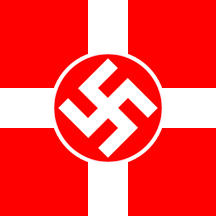
NSSAP Flag
c.1933-1938
(also used by NSSB)
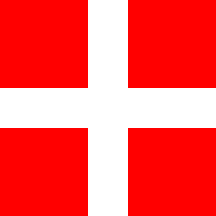
SNF Flag
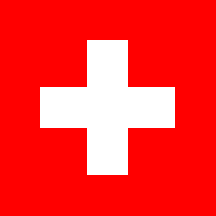
Swiss National Flag
|
National Socialist Swiss Workers' Party (Switzerland)
Nationalsozialistische Schweizerische Arbeiterpartei (NSSAP)
National Socialist Swiss Workers' Party is one of the Front Movement (Frontenbewegung) parties. It was founded in 1933 as the People's League (Volksbund) by the breakaway members of National Front under the leadership of Major Ernst Leonhardt, to be renamed in 1935, which was followed by Leonhardt's dismissal from the Army same year due to his Nazi attitudes. In 1938, party was forbidden to hold the rallies and publish its newspaper. Shortly afterwards, Leonhardt disbanded the party and replaced it same year with the Swiss Society of the Friends of Authoritarian Democracy (Schweizerische Gesellschaft der Freunde einer autoritären Demokratie). In late 1939, after a campaign against the Swiss government, followed by a series of trials of his party members, Leonhardt fled to Germany and Swiss Society of Friends of Authoritarian Democracy was banned in 1940 due to its subversive activities. In 1944, Leonhardt was sentenced to prison in absentia and was killed in Germany next year in an air raid.
The flag of the National Socialist Swiss Workers Party is derived from that of the Swiss National Front (SNF), by superimposing a red disk charged with a white swastika and fimbriated white. It s use was made illegal in 1938, when the Swiss government banned the use of "non-Swiss" political symbols by Swiss political parties, which was primarily aimed at the use of swastika.
National Socialist Swiss League (Switzerland)
Nationalsozialistischer Schweizerbund (NSSB)
National Socialist Swiss League was founded in 1941 by Franz Burri, a Nazi activist. Most of its members were Swiss people living in Germany, although it operated in Switzerland as well. This group was dissolved in June same year, after a number of Swiss Nazi activists were arrested and a number of others, including Burri, fled to Germany, continuing their activities from there, mainly calling for another Anschluss - that of Switzerland. After the war, Burri returned to Switzerland, where he was sentenced to 20 years imprisonment in 1948 for speaking against the independence of the country, but was freed in 1959 and lived until 1987.
While only circular badges of National Socialist Swiss League are currently known which repeat the same general design, it is possible that the National Socialist Swiss League reused the flag of the National Socialist Swiss Workers' Party, knowing that Ernst Leonhardt assisted in its founding and took part in its activities.
|
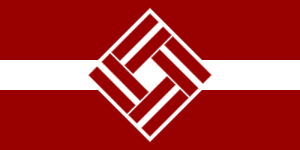
NSS Flag
|
National Force Union (Latvia)
Nacionala Speka Savieniba (NSS)
National Force Union was founded in 2003 by some of the former members of Helsinki-86, the oldest anti-Communist opposition group in Soviet Latvia, and claimed to be its successor, but promoted completely opposite ideas: hostility towards the ethnic minorities and LGBT people, creating a state which would impose "traditional values" on all of its citizens and control the economy completely in the name of "social justice", and campaigning to rehabilitate the Nazi collaborators from World War II as the "freedom fighters". The party also cooperated with similar groups from other countries through the short-lived European National Front. In 2008, having failed to apply for the re-registration, which was a mandatory part of the then political reforms, the party disbanded itself.
The flag of NSS was derived from the national flag of Latvia by adding the party emblem over all, a white diamond charged with four small patterns of national flag, arranged so as to resemble the swastika, which is claimed to make the basis for a variety of the folk art ornaments. All this symbolizes the unity and indivisibility of the country, as well as its four historic regions - Kurzeme, Vidzeme, Zemgale and Latgale. Also see National Union "Justice" and Fatherland Heritage Flag.
|
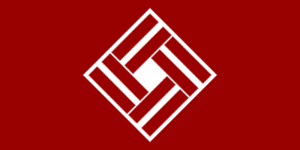
NST Flag
|
National Union "Justice" (Latvia)
Nacionala Savieniba "Taisnigums" (NST)
The party was founded in 2014 as the direct successor of Fatherland Heritage, as an attempt to keep spreading the same ideas through a new organization. It also uses the flag of its predecessor, which bears the emblem originally introduced by the National Force Union. However, promoting the same ideas under the same symbols, while changing only the name, seems not to have been very successful so far.
|

NSWP Flag - Type #1
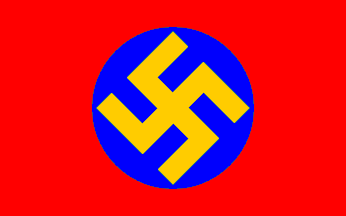
NSWP Flag - Type #2
|
National Socialist Workers Party 1933-1950 (Sweden)
National Socialist Workers Party was formed in 1933 as the breakaway group from the Swedish National Socialist Party (SNSP). Its leader Sven Olov Lindholm was originally the second-in-command in the SNSP. The party differed from other Swedish Nazi parties by insisting on anti-Capitalist nature of its ideology, which led to them being labelled as Strasserites (left-wing Nazis), especially after their name was changed to Swedish Socialist Coalition (Svensk Socialistisk Samling) in 1938 and use of swastika was abandoned along with most references to Nazism. The party, once a leading ultra-rightist group in Sweden, lost most of the support during the World War II, to be eventually disbanded in 1950.
Along with the blue flag (Type #1) charged with gold swastika, the party also used a red flag (Type #2) charged with gold swastika on blue disk. The Blue Type #1 would be adopted by the National Socialist Front (Nationalsocialistisk - NSF) in the 1990s.
The Red fielded variant (Type #2) was originally used by the Swedish National Socialist Party (Svenska Nationalsocialistiska Partiet). The use of both flags ceased with the NSWP renaming in 1938 and abandoning of swastika in favor of stylized wheat sheaf , originally the symbol of Vasa royal dynasty, which was already previously used in combination with swastika as one of the party emblems. (see the National Socialist Front 1994-2008 - NSF 2006 for an example) |
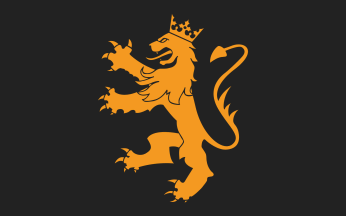
Current NU Flag 2013
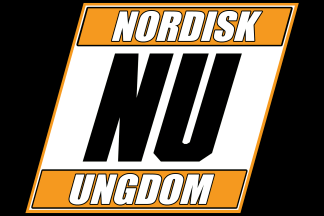
Old NU Flag
|
Nordic Youth (Sweden)
Nordisk Ungdom
The Nordic Youth was founded in 2010 by former members on National Democratic Youth (Nationaldemokratisk Ungdom), the youth wing of the far-right party National Democrats (Nationaldemokraterna). Its name had already been used by the youth wing of the National Socialist Workers Party/Swedish Socialist Coalition (1933-1950), but the two organizations are otherwise unrelated. Nordic Youth describes itself as an ethnopluralist movement claiming that it is not a white racist group and co-operates with radical Islamists as well, finding the common ground with these in the anti-Zionism and support for a free Palestine and claiming that it is "a good thing to work with groups who want to live according to their own culture, religion and tradition".
The current flag of Nordic Youth is black, charged with a crowned rampant lion in orange. Its first use was in 2013 at the Independence March in Warsaw, a yearly demonstration organized by Polish ultra-rightists. Lions appear on the coats-of-arms of all three Scandinavian countries, although this one mostly resembles the one from the Swedish coat of arms, which is in accordance with their insistence on both the Swedish nationalism and the Scandinavism, the latter being further emphasized by the use of a "Scandinavian" flag with red cross on yellow field, originally introduced sometime between 1979 and 1985 and attributed to the Union of Kalmar, the entity which grouped the whole Scandinavia under one ruler from 1397 to 1523.
An older black NU flag, still in use, contains a white "rhomboid" fimbriated orange, charged with large initials NU in black and then the full Nordisk Ungdom name inscribed in fimbriated white letters on two smaller orange rhomboids placed above and below the initials. This logo resembles those used by the European National Front member groups like the New Force of Italy and
New Right of Romania and Moldova. |
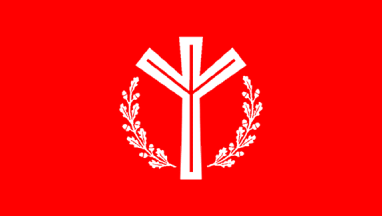
NV Flag
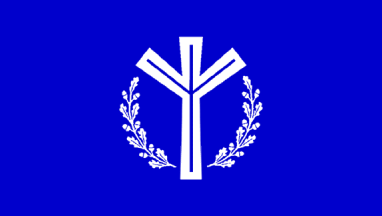
NV Michigan Division Flag
|
National Vanguard (USA)
The National Vanguard is an American White Supremacist organization based in Charlottesville, Virginia, that gained brief national notoriety when they dispatched a first response team after Hurricane Katrina with instructions to only help "white" families in Alabama and Mississippi. The NV was founded in 2005 by Kevin Alfred Strom and former members of the National Alliance. The next year, in 2006, several units of National Vanguard split off and left the NV to form a new White Supremacist organization called the Nationalist Coalition (still active in the St. Petersburg area of Florida), but a reduced NA continued to operate in the Charlottesville area after the split. In 2007, Strom was arrested for child pornography, and in 2008 he was sentenced to a two year sentence in prison. Until recently, however, the NV still continued to maintained a website featuring typical White Supremacist and hate articles.
The National Vanguard flag is charged with the same white "life" rune and oak branches used by the National Alliance, but has a plain red field. A version of the NV flag with blue field instead of red, was also reported in use by the now-defunct Michigan Division. It remains unclear whether this flag was only used in Michigan and whether the color change was related to the blue field of the Michigan state flag. |
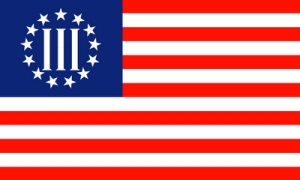
Gun Rights Flag
|
Nyberg Battle Flag of the Three Percent (USA) 2008
Based on the belief that during the American Revolution, the active forces in the field against the King's tyranny never amounted to more than 3% of the colonists, militia groups calling themselves by such names as the "Three Percenters," (Threepers), the "Sipsey Street Irregulars," and the "Oath Keepers" (led by Nevada lawyer Stewart Rhodes, a former staffer of Congressman Ron Paul), have sprung up expressing anti-government (current administration) and anti-gun control sentiments, during President Obama's first year in office. They claim to be the ones who "the Founders counted on to save the Republic when everyone else abandoned it."
Basically, they are extremist groups of American gun owners who are preparing to "defend" themselves and "their right to bare arms" against "enemies, foreign and domestic," and warn those they call "collectivists" (those who favor gun control), and who they feel control the government, to leave them and their guns alone. |
- My thanks to Rick Prohaska, David Ott, Tomislav Todorovic, and Chrystian Kretowicz for their help on this page -
Much of this information is borrowed, sometimes edited, modified, and shorten from longer articles in Wikipedia encyclopedia.
| Flags of Extremism Part 1 (a-m) | Flags of Extremism Part 2 (n) | Flags of Extremism Part 3 (o-z) |
|